Apollo 13
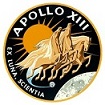
Day 1, part 2: Earth Orbit and Translunar Injection
Corrected Transcript and Commentary Copyright ©2014-2023 by W. David Woods, Johannes Kemppanen, Alexander Turhanov and Lennox J. Waugh. All rights reserved.
Last updated 2023-11-14
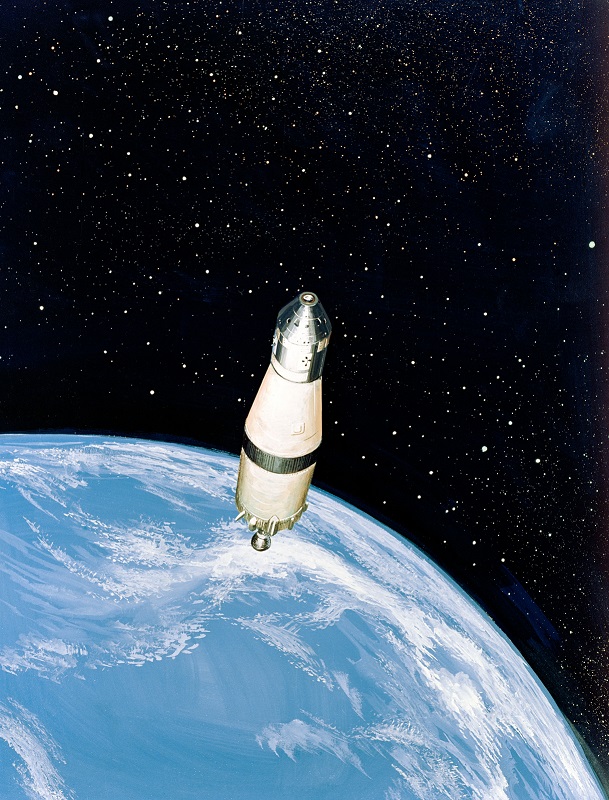
NASA artist's concept of the Apollo 8 S-IVB/Apollo stack soon after Translunar Injection. This work gives a good idea of what the stack looked like with the first and second stages gone.
000:14:57 Kerwin: Apollo 13, Houston. Your preliminary orbit down here is 102.5 times 100.3 [nautical miles, 189.8 by 185.8 km], and everything is looking good.
000:15:06 Lovell: Roger, Houston. And it looks good to be up here again.
000:15:10 Kerwin: I'll bet. [Long pause.]
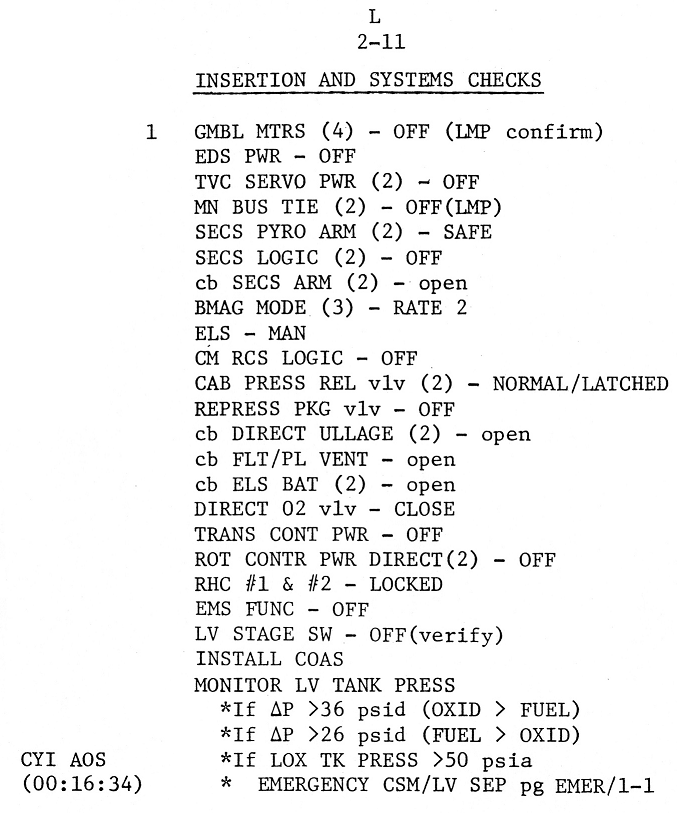
Step 1 of the post-insertion checklist.
000:15:34 Kerwin: Apollo 13, Houston. I have your Z torqueing angle. You ready? [Pause.]
000:15:42 Lovell: Jack is ready to copy, Joe.

Step 4 - the Z Torquing Angle Update
000:15:44 Kerwin: Okay. It's plus decimal 26. Over. [Pause.]
000:15:52 Swigert: Okay, Joe. Plus 0.26.
000:15:55 Kerwin: That's Roger.
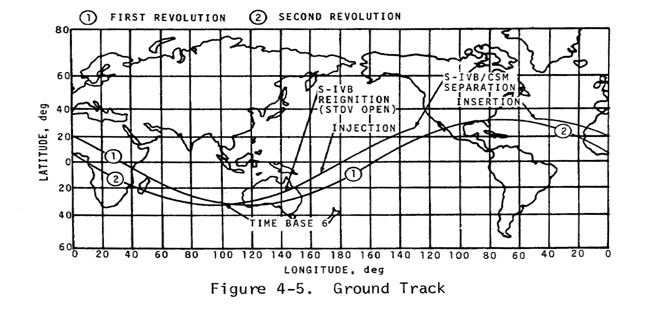
Apollo 13 ground track during its two Earth parking orbits.

Click to show a colored and animated globe version of the above ground track map.
This is Mission Control at 17 minutes. We've had Loss Of Signal with the spacecraft. We'll be reacquiring shortly through the Canary Island Tracking Station. The total burn duration on the third stage was about 45 seconds longer than planned; we would not expect at this point that this would have any serious effect on the Translunar Injection, the fact that we did consume a bit more propellant out of the third stage than was originally planned. We are standing by now for Acquisition Of Signal through the Canary Island Station. We should be reacquiring radio contact with the spacecraft shortly.
This is Apollo Control; we're still standing by for any conversation with the spacecraft over Canary Islands. The booster systems engineer reports that at this point he has no explanation for the early shutdown of the S-II - Saturn second stage - center engine.
000:21:39 Kerwin: Apollo 13, Houston.
000:21:42 Lovell: Go ahead, Houston.
000:21:44 Kerwin: Okay. Couple minutes to LOS, Jim. Everything is looking real good. Your AOS time at Carnarvon will be 52:36, and we don't have too much of a handle on why the inboard cut off early except that it apparently was an engine problem and not a switch select function. But we're certain that you'll be able to make TLI based on what we're looking at now.
000:22:11 Lovell: Roger. There's nothing like an interesting launch.
000:22:14 Kerwin: That's right. [Long pause.]
000:23:14 Kerwin: Apollo 13, Houston. Canary LOS in 30 seconds. Request Command Reset, please.
000:23:21 Lovell: Roger. Command Reset coming on.
000:23:24 Kerwin: Thank you. [Long pause.]

The Command Reset switch resets any remote commands Mission Control might have sent to the spacecraft. They are most often used to operate the onboard tape recorder. Original scan via heroicrelics.org
000:23:25 Swigert (onboard): Hey, you guys, are you ready? I've done my other item there; I'm ready to give you - [garble].
000:23:30 Lovell (onboard): Well, all right, fine. Let's just get this one done first.
000:23:33 Swigert (onboard): Okay.
000:23:34 Lovell (onboard): What else do you have to do here?
000:23:35 Haise (onboard): Okay. Going Bit Rate.
000:23:40 Kerwin: Apollo 13, Houston. Request Low Bit Rate, please. Over.
000:23:44 Lovell: Low Bit Rate.
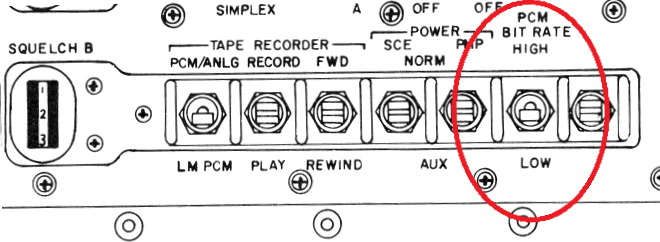
PCM BIT RATE selection switch on the bottom of Panel 3. Original scan via heroicrelics.org.
000:23:46 Unidentifiable crewmember (onboard): Okay.
000:23:47 Lovell (onboard): Okay. The pressure's okay?
000:23:49 Haise (onboard): Yes. Let's see now, Jim, there's one more reading there; you gave me the - you gave me the helium pressure, 4100. What's the manifold pressure on that one?
000:23:59 Lovell (onboard): The manifold pressure is reading about 80.
000:24:05 Haise (onboard): Eighty? Okay, give me the number 1, then.
00:24:07 Lovell (onboard): Okay, number 1. And helium temperature is 80, helium pressure is 4100, and the manifold pressure is about 100.
000:24:18 Haise (onboard): Manifold's about 100. Okay.

Step 6 - CM RCS Monitoring Check
000:24:19 Swigert (onboard): Okay, Freddo. Have a look - the cabin and suit doing? Before we...
000:24:22 Haise (onboard): They're both pretty equal, now, at about 5/5.
000:24:25 Swigert/Lovell (onboard): Okay.

Step 9
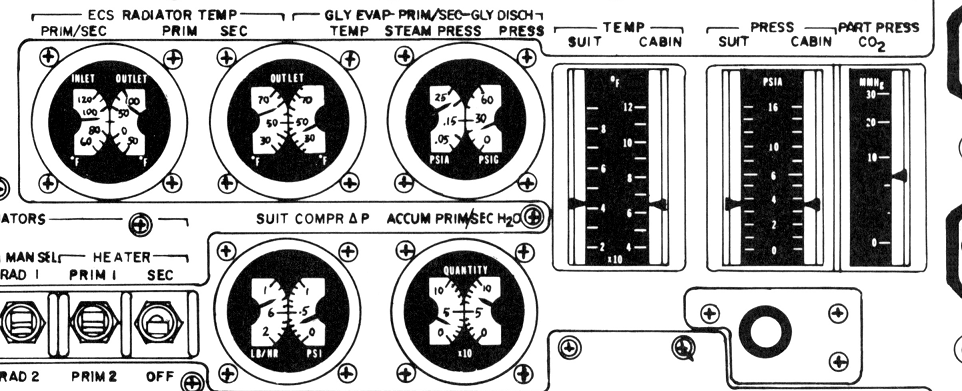
Environmental Control System displays. Scan via heroicrelics.org
000:24:26 Lovell (onboard): Well, let's - We'll break the [garble]
000:24:27 Swigert (onboard): Okay, let's do it. Freddo, here's your bag.
000:24:32 Haise (onboard): Okay. Jim.
This is Apollo Control. We've had Loss Of Signal now with the spacecraft at the Canary Island Tracking Station; we won't reacquire again until the spacecraft reaches the tracking station at Carnarvon, Australia. That will be at a Ground Elapsed Time of 52 minutes, 36 seconds. Recapping at the time we lost contact with the spacecraft through Canary Islands, we looked to be in very good shape for the Translunar Injection burn, with the Saturn third stage. The second stage center engine shut down about 2 minutes early; the total overburn time on the third stage was about 10 seconds. We don't expect that this would have any effect on the Translunar Injection. At 25 minutes, 20 seconds; this is Mission Control, Houston.
000:24:39 Haise (onboard): Okay, for that item, those two I can check off. You got the Z-torquing angle?
000:24:43 Swigert (onboard): Yes.
000:24:44 Haise (onboard): I've checked the caution and warning; you've done that. We're up - we're up to item 9.

Step 7 illuminates all the caution and warning lights and ensures that they are working properly.
000:24:49 Swigert (onboard): How we doing time line?
000:24:51 Haise (onboard): We're a little behind, but it's the kind of stuff that we can catch up lickety-split with.
000:24:57 Swigert (onboard): Okay.
000:25:04 Haise (onboard) : Okay. Let me get - make sure I got this item. I want A, Simplex. Hell, it was already there. B to Off. No, it wasn't. It's just a hard switch again. They really fake you out, these switches...

Step 13
000:25:18 Swigert (onboard): Yes. I've noticed...
000:25:19 Haise (onboard): ...they move so hard.
000:25:20 Swigert (onboard): I've noticed that, Fred.
000:25:21 Haise (onboard): Compared with the simulator. Okay, let me check item 13 off; I've completed that one. Let's see.
000:25:30 Swigert (onboard): Yes. I've got...
000:25:37 Lovell (onboard): Jack, be careful in your movements now.
000:25:39 Swigert (onboard): Yes. I'm not having any problems so far.
000:25:41 Lovell (onboard): Okay.
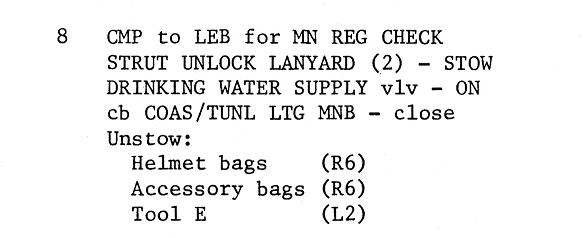
Step 8
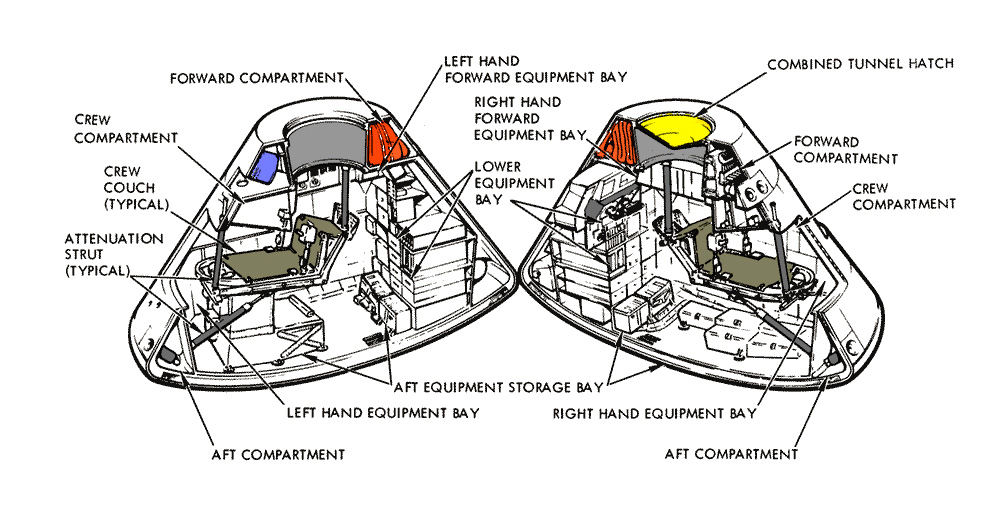
A cutaway of the Command Module, seen from port and starboard angles.
000:25:43 Haise (onboard): PCM Bit Rate is Low. I did the Command Reset in Normal. I'll do it again, just to make sure. I have an A, Simplex, and B, Off. That's great. Jack, could you hand me one thing?
000:25:58 Swigert (onboard): What - what would you like?
000:25:59 Haise (onboard): One of those spring jobbers, there, I can...
000:26:00 Swigert (onboard): Yes.
000:26:01 Haise (onboard): ...flip across...
000:26:02 Swigert (onboard): I was going to ask you, if you wanted one of those, Fred.
000:26:03 Haise (onboard): Yes. Okay. Now that'll take care of my checklist for me.
000:26:15 Swigert (onboard): A springy jobber coming up.
000:26:17 Haise (onboard): Thank you. No, no; you got one of the other ones with the hook?
000:26:24 Swigert (onboard): I got the wrong kind?
000:26:25 Haise (onboard): Yes. It's a little longer one with the hook.
000:26:28 Swigert (onboard): Are they in the same - They in the same - [garble]?
000:26:35 Haise (onboard): Now that's a good question.
000:26:37 Swigert (onboard): Well, I'll tell you - Let me - I don't see them down here, now.
000:26:41 Haise (onboard): Sure enough. It really is zero g.
000:26:47 Lovell (onboard): Well, gentlemen, I'll break out my two gold pens.
000:26:50 Haise (onboard): The longest Napierian trajectory in the world.
000:26:56 Swigert (onboard): Yes. We had - I had a long boost ride, didn't we?
000:26:59 Haise (onboard): Man!
000:27:00 Lovell (onboard): Twelve minutes and 30 some seconds.
000:27:01 Haise (onboard): I'll tell you, gang, I was a little worried for a pinch or two.
000:27:04 Lovell (onboard): When I called, 'Inboard,' I was - It was natural; then I looked at the time...
000:27:07 Swigert (onboard): Yes...
000:27:08 Lovell (onboard): ...and I said, 'That's not natural.'
000:27:09 Swigert (onboard): We were 2 minutes early. Five minutes and 32 seconds, if you want to write that down.
000:27:12 Lovell (onboard): Okay, good. Okay, my helmet coming off.
000:27:15 Haise (onboard): Shoot, if they recorded that...
000:27:16 Swigert (onboard): ...(Laughter) Yes...
000:27:17 Haise (onboard): ...it'd be heck.
000:27:18 Swigert (onboard): (Laughter) I know it.
000:27:24 Swigert (onboard): Well, you know, I think I'll just - I'll just let this thing pull right up to the top.
000:27:29 Haise (onboard): You haven't found that other one, yet, have you?
000:27:30 Swigert (onboard): No, Fred; I haven't...
000:27:32 Lovell (onboard): What are you looking for?
000:27:33 Haise (onboard): A clamp. Oh...
000:27:35 Swigert (onboard): I think those are down - those are in one of the lower...
000:27:38 Haise (onboard): Okay. You want to give me that other one back here, I'll see if I - Trouble is, I got no hooks that are the right length apart for my goddamn [garble]. Fiddle with it. I'll just hang on to it tight and [garble].
000:27:55 Swigert (onboard): By golly! Guys!
000:28:03 Swigert (onboard): Hey, that's - All that stuff about the helmets being hard to get into the bag is the truth.
000:28:15 Lovell (onboard): Okay, let's see. At [garble] 52:36, we're going to pick them up over Canaries.
000:28:20 Haise (onboard): Great...
000:28:21 Lovell (onboard): And, gentlemen, you are now passing the beautiful Atlantic Ocean.
000:28:30 Haise (onboard): I'm glad we checked PGNCS.
000:28:37 Lovell (onboard): Say, I never thought - You guys want to take a look - look at - Excuse me a second. I'm going to turn out those floodlights. I wanted to show [garble] - When I turn out all the lights in just a second, you can see thunder and lightning on the horizon.
000:28:55 Swigert (onboard): Sure as hell can.
000:28:56 Lovell (onboard): And also, you might be able, if your eyes become accustomed to it - you might be able to see the - the airglow. There, you can. You can see the airglow.
000:29:05 Swigert (onboard): Yes. I sure can.
000:29:06 Lovell (onboard): See that airglow?
000:29:07 Swigert (onboard): I can see that lightning, too.
000:29:09 Haise (onboard): Oh, I - I won't be able to see [garble]
000:29:10 Swigert (onboard): Hey, that's...
000:29:12 Haise (onboard): El Scorpio, isn't it?
000:29:13 Lovell (onboard): Yes, but see the - Antares is in the airglow layer.
000:29:16 Swigert (onboard): Yes, it is. Right in it.
000:29:18 Lovell (onboard): And then right below that, way - about a half a degree, that's...
000:29:20 Swigert (onboard): The next star down there?
000:29:21 Lovell (onboard): Yes.
000:29:22 Haise (onboard): Yes.
000:29:23 Lovell (onboard): So, if you lift the lights, we'll see again.
000:29:27 Swigert (onboard): Okay, I'm ready for the main Reg check, Fred, if you're ready.
000:29:30 Haise (onboard): Okay. Go ahead. I'll tell you when. [Garble] just call it on.
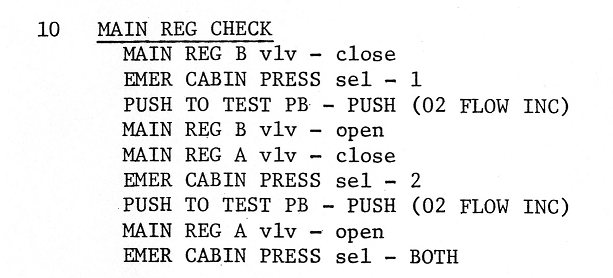
Step 10

Panel 351, Environmental Control System
000:29:35 Swigert (onboard): Okay. Main Reg B going closed. Emergency Cabin Pressure selector 1, Push To Test.
000:29:45 Haise (onboard): Did you Push To Test?
000:29:46 Swigert (onboard): Yes. There it is.
000:29:47 Haise (onboard): Good.
000:29:48 Swigert (onboard): Okay.
000:29:49 Haise (onboard): Good.
000:29:50 Swigert (onboard): Main Reg B valve, Open; A going closed.
000:29:54 Haise (onboard): Closed. Next step?
000:29:55 Swigert (onboard): Cabin - Cabin Pressure selector 2, Push To Test.
000:30:00 Haise (onboard): Okay, that's good.
000:30:02 Swigert (onboard): Main Reg valve B ... or A, Open, and Emergency Cabin Pressure selector, closed. Okay, Jim. I got to get to ... to those [garble] here.
000:30:14 Lovell (onboard): Okay.
000:30:23 Lovell (onboard): Okay.
000:30:24 Swigert (onboard): [garble] down there?
000:30:27 Haise (onboard): Up in L-2, Jack.
000:30:28 Swigert (onboard): Yes, that's where I'm looking.
000:30:32 Haise (onboard): You're kidding. I thought you said the helmet was tough to get in this bag. Piece of cake. Have you got - have you got one of those big helmets?
000:30:41 Swigert (onboard): Yes - No, I don't think - unless I got a bigger head.
000:30:44 Haise (onboard): You don't have a Borman special, do you?
000:30:46 Swigert (onboard): No.
000:30:47 Lovell (onboard): We all have Borman specials.
000:30:48 Swigert (onboard): Really?
000:30:49 Lovell (onboard): Yes.
000:30:50 Swigert (onboard): Maybe your damn bag won't fit anymore with that one [garble] have to slip it in this one.
000:30:54 Haise (onboard): Yes. [garble] a little bit. I got a [garble]
000:31:06 Lovell (onboard): Okay. Got a [garble]?
000:31:09 Swigert (onboard): Yes.
000:31:12 Lovell (onboard): Well, is there anything else we can be doing right now? Like COAS?
000:31:14 Haise (onboard): Yes.
000:31:15 Swigert (onboard): You can...
000:31:16 Lovell (onboard): Yes.
000:31:17 Swigert (onboard): ...you can get out the ORDEAL box, if you could...
000:31:18 Lovell (onboard): Yes...
000:31:19 Swigert (onboard): ...could you do that, Jim?
000:31:20 Lovell (onboard): I'm going to try it right now.
000:31:21 Swigert (onboard): That would save me a trip down under there.
000:31:22 Lovell (onboard): Okay, that's right.
000:31:25 Swigert (onboard): Okay. Okay...
000:31:28 Lovell (onboard): You got to watch the time right now for...
000:31:29 Swigert (onboard): Yes.
000:31:30 Lovell (onboard): Okay.
000:31:35 Swigert (onboard): I don't - I got to go stow my water wings. You guys got your water wings on?
000:31:40 Haise (onboard): No. I don't think I'm going to fiddle with that right now, Jack. They're not in my way.
000:31:45 Swigert (onboard): Yes. I'll trade. We can get that later.
000:31:46 Haise (onboard): Hell, yes.
000:31:48 Lovell (onboard): Well, I'll tell you what - I blew mine on 8.
000:31:52 Swigert (onboard): Did you?
000:31:53 Haise (onboard): Yes. But you were the guy that - Jack should take his off. He's the guy moving around.
000:31:57 Lovell (onboard): You're right.
000:31:58 Swigert (onboard): Okay. I'll take mine off.
000:32:00 Lovell (onboard): [Garble] really want [garble].
000:32:05 Haise (onboard): Man, I'll tell you, that first stage...
000:32:08 Swigert (onboard): [Garble.]
000:32:09 Haise (onboard): When that shut down, man, I thought I was going through the instrument panel. I'll tell you, that was - I was so surprised [garble] I had heard about it.
000:32:20 Lovell (onboard): I should have warned you.
000:32:22 Haise (onboard): [Laughter.]
000:32:23 Swigert (onboard): Yes, well. Something else...
000:32:24 Haise (onboard): Well...
000:32:26 Swigert (onboard): ...you got to get into.
000:32:27 Lovell (onboard): [Garble] right in [garble].
000:32:28 Haise (onboard): Okay, let's see. Confirm normal, we've done that. We've stowed the water wings. Now it's the TSB is the only item left outstanding there.

Step 9
000:32:36 Lovell (onboard): Okay, I have the ORDEAL in place. Now, do you want the camera bracket?

Steps 19 and 20
000:32:44 Swigert (onboard): Yes, you better leave that camera bracket up there.
000:32:50 Haise (onboard): Yes. Yes, I can feel a little bit of the zero-g effect, a little flushing in the face.
000:32:54 Swigert (onboard): Yes.
000:32:55 Lovell (onboard): Yes, that's that - Your blood rushes to your head because your heart doesn't have anything to pump against.
000:33:02 Swigert (onboard): Yes, I can feel that, too.
000:33:05 Lovell (onboard): Okay, I have the camera bracket.
000:33:08 Swigert (onboard): Okay, have you got the - the ORDEAL mounted? I have...
000:33:10 Lovell (onboard): The ORDEAL is mounted.
000:33:11 Swigert (onboard): ...[Garble]...
000:33:12 Haise (onboard): Okay, Jim. Are you ready to get busy on getting the RADs on the line?
000:33:16 Lovell (onboard): I sure am.
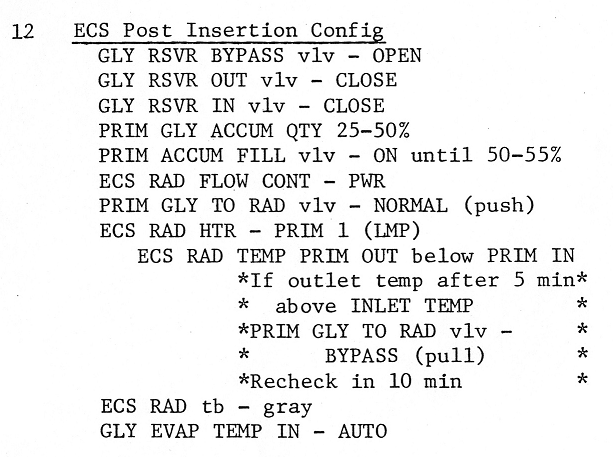
Step 12
000:33:17 Haise (onboard): Glycol Reservoir Bypass valve, Open.
000:33:19 Lovell (onboard): Okay, Glycol Reservoir Bypass valve to Open.
000:33:25 Haise (onboard): Okay, Out valve, Close.
000:33:27 Lovell (onboard): Out valve, Close.
000:33:29 Haise (onboard): The In valve, Close.
000:33:31 Lovell (onboard): The In valve going Close.
000:33:34 Haise (onboard): Okay, now we need a little bit of quantity in the Accum - not the Accum, but we need the fuel valve on for about 5 percent on down to 45 percent. That's about what it was in the [garble], too.
000:33:46 Lovell (onboard): Okay, what I'm going to do is...
000:33:47 Haise (onboard): CapCom said they wanted 50.
000:33:48 Lovell (onboard): ...[Garble] the ORDEAL, then. The number 1 ball. Did you check the Verb 82?
000:33:57 Swigert (onboard): Yes, I did. I wrote it down.
000:33:59 Lovell (onboard): Okay.
000:34:00 Swigert (onboard): I did that whole thing.
000:34:01 Haise (onboard): And we got the secondary RAD leak check to go. We got 'Unstow and mount TSB.'

Step 11
000:34:07 Swigert (onboard): Yes. I [garble] done that, too.
000:34:10 Haise (onboard): And I got water wings in my lap here. That's it on that item - that page; it's done. So we're hanging up here. Let me proceed ahead and see what I can. I can do a purge. There are not any left for another 12 minutes or so.
000:34:28 Swigert (onboard): Let me get the...
000:34:29 Haise (onboard): [Garble.]
000:34:30 Swigert (onboard): I got to get...
000:34:31 Haise (onboard): EPS monitor check, I can do [garble] I've been looking ahead to see what Jim can do. It says a GDC align somewhere in this thing.
000:34:36 Lovell (onboard): Okay, I'm setting the ORDEAL right now.
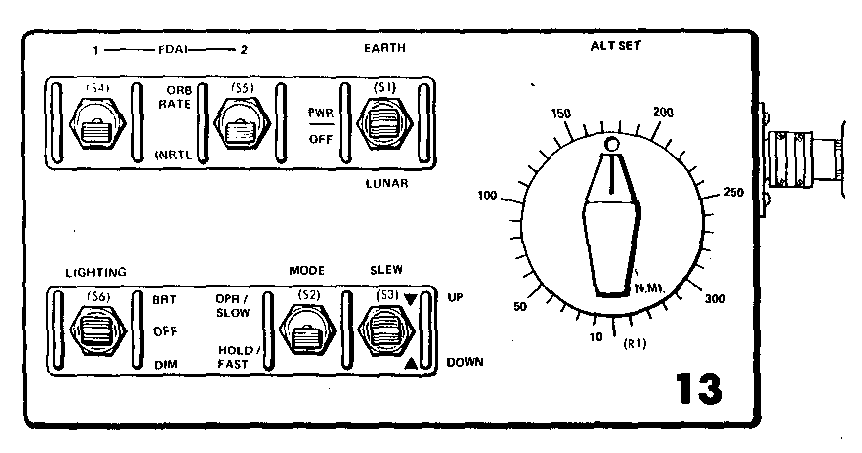
ORDEAL box diagram.
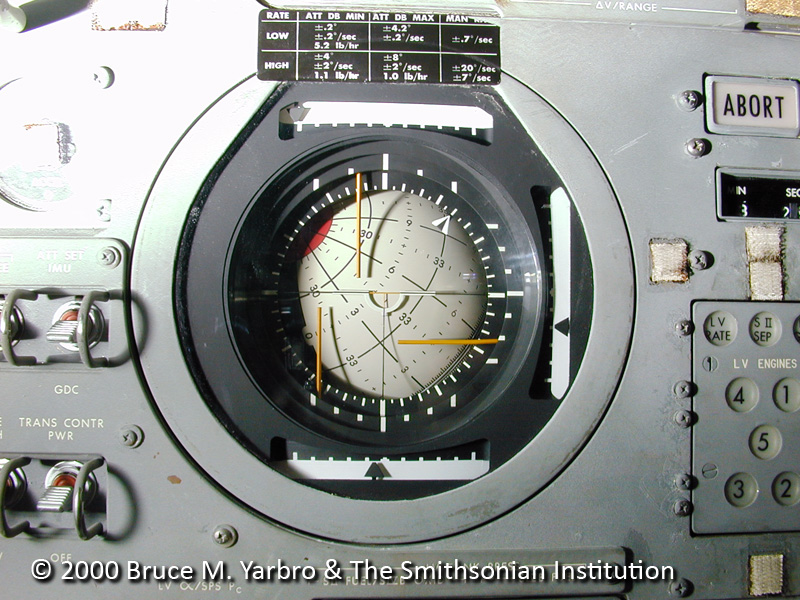
Apollo 13's FDAI 8-ball photographed inside the CM.
000:34:40 Haise (onboard): Okay, well, that's the next thing you can do is a GDC align. Okay, you may - you may get some Master Alarms here, gang. I'm going to be doing a purge check. I'll just do the...

Step 14
000:34:55 Swigert (onboard): Fredo.
000:34:56 Haise (onboard): Yes.
000:34:57 Swigert (onboard): Look what I got.
000:34:58 Haise (onboard): What have you got?
000:34:59 Swigert (onboard): One with a hook on the end of it.
000:35:01 Haise (onboard): Beautiful.
000:35:02 Swigert (onboard): Spring jobber-do.
000:35:03 Haise (onboard): Thank you.
000:35:09 Lovell (onboard): Now, is there anything I can be doing?
000:35:10 Swigert (onboard): I am giving you the sequence camera here, Jim.
000:35:13 Lovell (onboard): Okay.
000:35:14 Swigert (onboard): I tell you, I haven't checked the setting.
000:35:16 Lovell (onboard): How about your optics?
000:35:17 Swigert (onboard): I've got them unstowed. Now. [garble] that'd be 32.
000:35:32 Swigert (onboard): [Garble] camera. Here's the power cable.
000:35:36 Lovell (onboard): Thank you. Okay, 18 millimeter, f:8, and 250th.
000:35:47 Swigert (onboard): Now, let's see. Let me give you a - it's f:8, 250th, 7 feet, 12 frames per second.
000:35:54 Lovell (onboard): Okay. Go.
000:35:55 Swigert (onboard): Magazine A.
000:35:56 Lovell (onboard): Magazine A is on.
000:35:58 Haise (onboard): Hey, Jack, where'd you find these?
000:36:00 Swigert (onboard): I found it right down in - Fred, in this stowage...
000:36:03 Haise (onboard): Do you have any longer ones?
000:36:04 Swigert (onboard): No.
000:36:05 Haise (onboard): (Laughter)
000:36:06 Swigert (onboard): No. It...
000:36:07 Haise (onboard): But that wasn't quite that long.
000:36:08 Swigert (onboard): Yes, I know they do. And I'll tell you where it is; it's down in...
000:36:10 Haise (onboard): Okay.
000:36:11 Swigert (onboard): ...A-8. Can you make do with that for a minute?
000:36:13 Haise (onboard): Yes. I [garble].
000:36:14 Swigert (onboard): Until I get - Okay, have you got ORDEAL - You got ORDEAL mounted?
000:36:22 Lovell (onboard): I - I have ORDEAL mounted.
000:36:24 Swigert (onboard): There we go.
000:36:25 Haise (onboard): Okay...
000:36:26 Swigert (onboard): I got to get...
000:36:27 Haise (onboard): ...right after - When did we insert, gang? Twelve something?
000:36:31 Lovell (onboard): 12:32 [garble]
000:36:33 Haise (onboard): Okay. I'm looking for where I put the first line heater on, so it was roughly about 14 minutes. We've been - we've been 20 minutes. Yes. [garble] Okay [garble].
000:36:43 Lovell (onboard): Don't forget I still got the radiators bypassed here.
000:36:45 Haise (onboard): Yes. Okay, what I need though, Jim, is to - We got to pump up the - You want to - Let's finish that item. I need to pump up the accumulator a little bit. I mean use the accumulator to - Yes - to get it up to 50 percent.
000:36:58 Lovell (onboard): Okay, you tell me what you want me to do here and I'll...
000:37:01 Haise (onboard): Can you reach the Prim Accum Fill valve, right there on your left?
000:37:05 Lovell (onboard): I'll try.
000:37:07 Haise (onboard): Yes, that's the Primary. How are you doing, Jack?
000:37:11 Swigert (onboard): Okay.
000:37:12 Haise (onboard): My countdown under way already?
000:37:13 Swigert (onboard): Yes. But, you want to have a few [garble]?
000:37:19 Haise (onboard): Yes.
000:37:32 Lovell (onboard): Okay, I'm putting the cable for you.
000:37:39 Haise (onboard): Excuse me a second; I want to [garble] the O
2 flow. Okay. Looks good. But if we get a Master Alarm, it'll come on with the H
2. Okay? Fuel cell 2. O
2 flow.
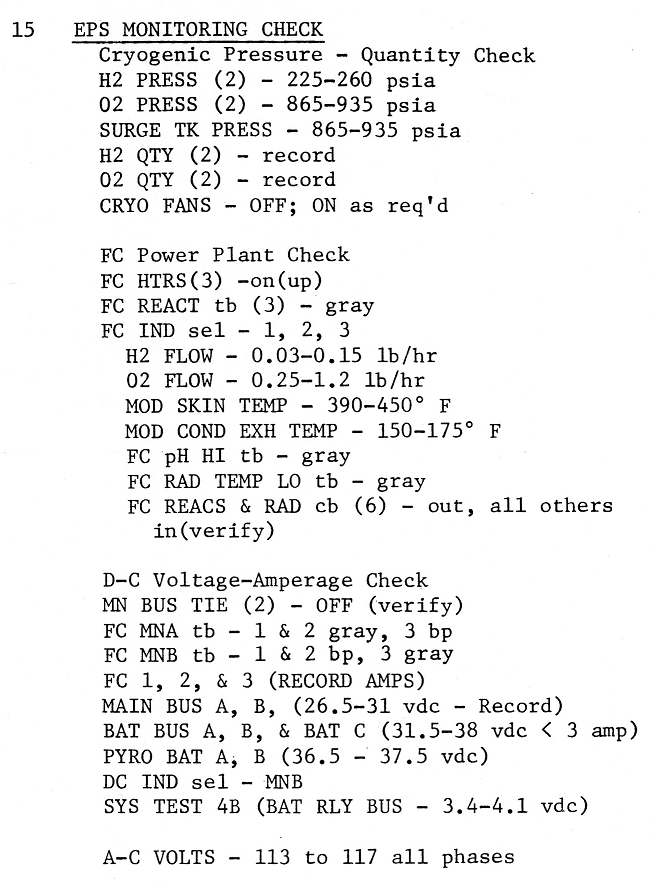
Step 15
000:37:56 Unidentifiable crewmember (onboard): [Garble.]
000:37:57 Haise (onboard): When it comes up flow, the H
2 banks up there like crazy. Looks like the simulator. The O
2 isn't like the simulator. Yes, it gets up there real slow. That old H
2 - Stand by for another Master Alarm. It banked up there like nothing flat. Okay. They're all back down to...
000:38:20 Swigert (onboard): Before I get the...
000:38:21 Haise (onboard): ...normal.
000:38:22 Swigert (onboard): ...TSBs out, can I get P52 [garble] program start?
000:38:27 Lovell (onboard): Yes. Go ahead.
000:38:28 Haise (onboard): Yes.
000:38:29 Lovell (onboard): Get it to cover one that that doesn't.
000:38:31 Swigert (onboard): Yes. I'll [garble].
000:38:34 Multiple speakers (onboard): [Garble.]
000:38:35 Lovell (onboard): That's the fourth, Jack. Better do that.
000:38:37 Haise (onboard): Okay. It's all optic tracking. I've done that. Zero [garble] G&N Power Optics, on, up. Optics Mode, Manual. [Garble] Direct [garble] High. OHC, Max right.
000:39:01 Lovell (onboard): Okay, do I have a tool there someplace? Can I use an E tool?
000:39:09 Haise (onboard): [Garble.]
000:39:11 Lovell (onboard): You got it uncovered?
000:39:13 Haise (onboard): Got tool E?
000:39:14 Lovell (onboard): Yes, until I get that up for a fit.
000:39:15 Haise (onboard): Okay [garble].
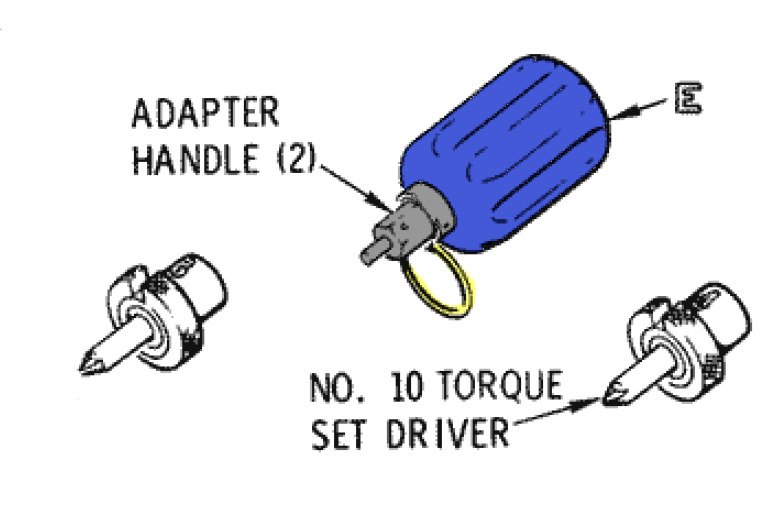
The multipurpose Tool E.
000:39:17 Lovell (onboard): Now, Fred, what do you want me to do?
000:39:19 Haise (onboard): Okay, next - next thing is to - [garble] back - page - I need to find the [garble] fuel valve on. You can't take your eye off it. I got him out the window. Is that it? I got the airglow there.
000:39:43 Lovell (onboard): Okay.
000:39:52 Haise (onboard): Make sure you get the right one, Jim. Primary Accum...
000:39:54 Lovell (onboard): Yes. I got it - I got - I got my - If I can get my hand down there, I got it made.
000:40:01 Swigert (onboard): Let me know when you turn them on. I only need about 5 percent; I don't need much.
000:40:13 Lovell (onboard): Okay. Coming On.
000:40:17 Swigert (onboard): Good. That's good. [garble] Off.
000:40:19 Lovell (onboard): Off.
000:40:20 Swigert (onboard): Okay, let me look a minute, here; I have to stabilize.
000:40:23 Haise (onboard): [Garble] up there.
000:40:25 Swigert (onboard): Okay. About one more shot.
000:40:27 Lovell (onboard): [Garble.]
000:40:31 Swigert (onboard): [Garble] slowly, that really [garble].
000:40:32 Lovell (onboard): Okay, how's that?
000:40:33 Swigert (onboard): That's good. Off.
000:40:35 Haise (onboard): [Garble] back down there [garble] go to Off.
000:40:38 Swigert (onboard): It's right at 50, though; the hell with it, that's good.
000:40:40 Lovell (onboard): Is it good?
000:40:41 Swigert (onboard): Yes; that's about 49.9.
000:40:45 Lovell (onboard): Okay.
000:40:46 Swigert (onboard): It is definitely Off, right?
000:40:47 Lovell (onboard): Yes.
000:40:49 Swigert (onboard): ECS RAD Control; let me go to Power. Okay, PRIM Glycol To RADs out, Jim; Normal, push - Normal, push in.
000:40:59 Lovell (onboard): Okay.
000:41:03 Swigert (onboard): Oh, I know - Hey, how about giving me - Do I have G&N Power at 8:21?
000:41:07 Haise (onboard): Yes, sir.
000:41:08 Swigert (onboard): Okay.
000:41:09 Haise (onboard): You got it.
000:41:10 Swigert (onboard): Okay.
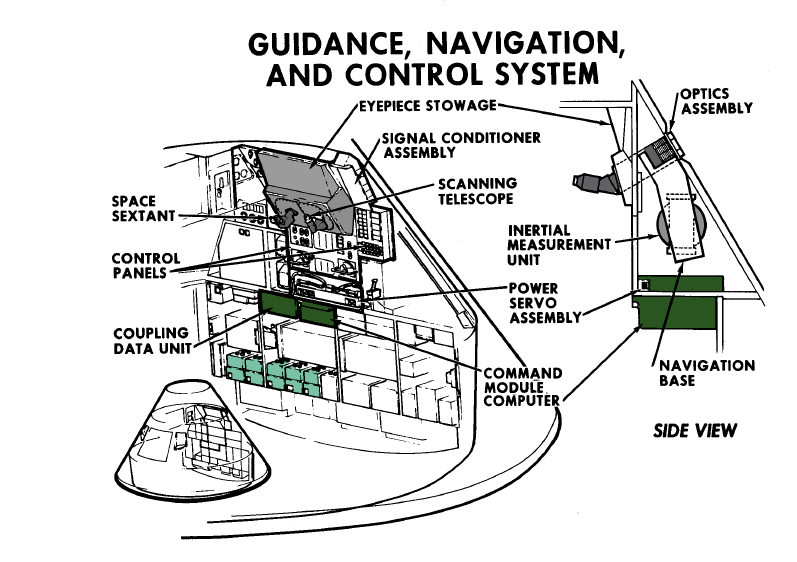
GNC workstation in the Lower Equipment Bay.
000:41:12 Haise (onboard): I'll get it ready for you [garble] stars out there.
000:41:20 Swigert (onboard): I've got a star in the...
000:41:22 Lovell (onboard): Sextant?
000:41:23 Swigert (onboard): ...sextant, but I have nothing in the...
000:41:26 Lovell (onboard): Well, it might take a while to do it with the scanning telescope, because your eyes have to get accustomed to it. It might not be where there are stars.
000:41:36 Swigert (onboard): Well, I've got one in the - I've got one in the...
000:41:40 Lovell (onboard): What star did you pick?
000:41:43 Swigert (onboard): 24.
000:41:44 Lovell (onboard): 24, that's - Gienah. Is it right on in the sextant?
000:41:52 Swigert (onboard): [Garble.]
000:41:54 Haise (onboard): Okay, while you got the tool and you're over there, Jim, do you think you could get the secondary Rad loop check done?
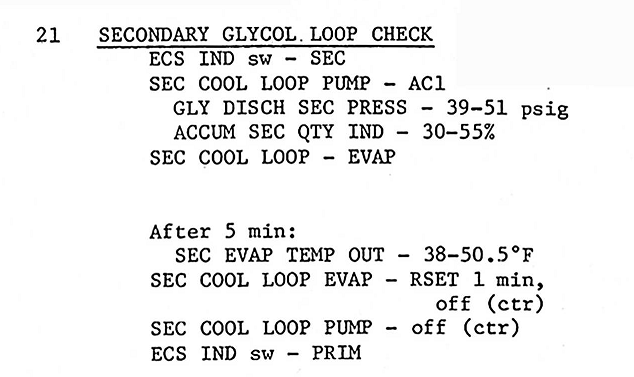
Step 21
000:41:59 Lovell (onboard): Yes.
000:42:00 Haise (onboard): That's the guy way down there, the very...
000:42:04 Swigert (onboard): [Garble]...
000:42:05 Lovell (onboard): We'll run through it, Jack, if you could...
000:42:10 Swigert (onboard): [Garble.]
000:42:14 Lovell (onboard): Mark it [garble] Okay, Glycol To Radiator, Secondary?
000:42:18 Swigert (onboard): [Garble.]
000:42:19 Haise (onboard): Yes, but it's to - RAD Normal. Let me know when. I'll start my watch.
000:42:28 Swigert (onboard): Hey, there - there we go. Now I got stars. I don't think they [garble] until just now.
000:42:34 Lovell (onboard): Okay, I'm going to take her to Normal now.
000:42:36 Swigert (onboard): Beautiful, gang.
000:42:37 Haise (onboard): All right.
000:42:39 Lovell (onboard): Oh, I don't know if I did it or not.
000:42:41 Haise (onboard): You - you turned it?
000:42:42 Lovell (onboard): I don't think so, I think [garble] right in there.
000:42:44 Swigert (onboard): Spica's right in there, you guys.
000:42:48 Haise (onboard): Okay.
000:42:50 Lovell (onboard): I - You know, I can get down there good, but I'm always on...
000:42:54 Haise (onboard): Well, you'd know if you got the screw in the slot.
000:42:59 Lovell (onboard): Okay, now.
000:43:01 Haise (onboard): Okay. Starting my watch. It's on Secondary.
000:43:03 Lovell (onboard): No, it's Normal now.
000:43:04 Haise (onboard): Okay, you've got to leave it there for 30 seconds.
000:43:06 Lovell (onboard): Okay. Could you tell?
000:43:11 Haise (onboard): What's that?
000:43:12 Lovell (onboard): Could you tell?
000:43:13 Haise (onboard): Tell what?
000:43:14 Lovell (onboard): That I'm in Normal?
000:43:15 Haise (onboard): Yes.
000:43:26 Swigert (onboard): [Garble.] Good old Antares.
000:43:33 Haise (onboard): Okay, that's it; put it back to close or off or wherever it...
000:43:36 Lovell (onboard): Bypass.
000:43:37 Haise (onboard): Bypass. Good. [Garble] Bypass?
000:43:40 Lovell (onboard): [Garble] Bypass.
000:43:41 Swigert (onboard): Well, he didn't show anything [garble]...
000:43:43 Lovell (onboard): Okay, how is it? Okay?
000:43:44 Swigert (onboard): Yes. Looks good.
000:43:46 Haise (onboard): Okay, I'm on page 2-14; coming up to EPS monitor check...

EPS Monitoring Check
000:43:50 Lovell (onboard): Okay, just be sure you...
000:43:51 Haise (onboard): ...EPS. Checking them off.
000:43:53 Lovell (onboard): Check them all off, and [garble]...
000:43:56 Haise (onboard): You got to do a GDC align...
000:43:58 Lovell (onboard): I'll do that right now.
000:43:59 Haise (onboard): You've got the sequence camera bracket and the ORDEAL, right?
000:44:02 Lovell (onboard): And those are all mounted, and we're all running on...
000:44:04 Haise (onboard): Okay, ORDEAL...
000:44:05 Swigert (onboard): Hey, guys? Sorry.
000:44:07 Haise (onboard): [Garble.]
000:44:08 Lovell (onboard): Yes. Okay, better record this down [garble]...
000:44:10 Swigert (onboard): I ain't got - I ain't going to let that pass, man...
000:44:13 Lovell (onboard): No?
000:44:14 Swigert (onboard): ...[garble] triangle bigger than hell.
000:44:15 Lovell (onboard): I'll give you a gold - gold star.
000:44:19 Haise (onboard): [Garble] got all that in your book, Jack?
000:44:21 Swigert (onboard): Yes. I'm going to write it on a [garble] here.
000:44:22 Haise (onboard): Okay.
000:44:23 Lovell (onboard): I'll do a GDC align now, Fred.
000:44:25 Haise (onboard): Okay. Now I'm here, I'm going to go ahead and [garble] the secondary loop. Okay, Secondary Loop is coming on line, gang; AC-1...
000:44:37 Swigert (onboard): Okay. Do we have to wait for MSFN to torque this?
000:44:40 Haise (onboard): That's that little extra whining you hear, and it's the Secondary Loop.
000:44:43 Lovell (onboard): Okay.
000:44:46 Haise (onboard): Okay. [Garble] go to the [garble].
000:44:49 Lovell (onboard): I can see the sludges in the [garble] burn.
000:44:53 Haise (onboard): Yes.
000:44:56 Swigert (onboard): Damn! Sort of lost him.
000:45:01 Haise (onboard): Okay. So that one is done, done...
000:45:04 Swigert (onboard): Okay...
000:45:05 Haise (onboard): ...done, done, done to there...
000:45:06 Swigert (onboard): Jim?
000:45:07 Lovell (onboard): Stand by.
000:45:08 Swigert (onboard): Do I need a - to get MSFN? I don't need them to torque here, do I?
000:45:13 Lovell (onboard): I don't think so - Wait - Where are the torquing angles [garble]?
000:45:16 Swigert (onboard): I've got the torqueing angles; let's see - [garble] - and it's 0.162 which is quite a bit less than - [garbled]
000:45:40 Haise (onboard): Okay, Jack, did you ever get my Main B breaker in down there?
000:45:44 Swigert (onboard): Yes, I did, in your COAS?
000:45:45 Haise (onboard): Yes.
000:45:46 Swigert (onboard): Main B? I did.
000:45:47 Haise (onboard): Yes. That's right.
000:45:48 Swigert (onboard): That's done.
000:45:49 Haise (onboard): And - let me verify that the RADs and REACS CB sticks are out, and - off.
000:45:53 Swigert (onboard): Okay. [Garble.]
000:45:56 Haise (onboard): Okay. I'll verify the Main Bus Ties are Off...
000:45:59 Lovell (onboard): GDC's aligned. 46 now. How we doing on the time line, Fred?
000:46:06 Haise (onboard): Let's see, we're not - we're coming up 6 minutes - What we got to do is get the cameras ... get the TV camera out next. We're about fixed.
000:46:18 Lovell (onboard): Okay.
000:46:19 Haise (onboard): 01:05 is when I got to start playing with the TV.
000:46:22 Lovell (onboard): Okay.
000:46:23 Haise (onboard): After we get our HSK LOS.
000:46:26 Swigert (onboard): [Garble.]
000:46:28 Lovell (onboard): If you have time, I would suggest that you adjust your straps and strap it in again for TLI ... just to make sure you got them okay.
000:46:40 Haise (onboard): Okay. Still pressing on in here, and Jack's got to do that [garble]; I'll circle it.
000:46:47 Swigert (onboard): Okay, what do you have to do?
000:46:48 Haise (onboard): The RADs and REAC breakers, six of them, out [garble].
000:46:55 Swigert (onboard): Rad, Reac, Reac, Reac - Okay, I can verify three Rads and three Reacs out.
000:47:03 Haise (onboard): Okay, good show.
000:47:17 Haise (onboard): Main A-1 - Main A-2...
000:47:34 Haise (onboard): Okay. Bus voltage [garble].
000:47:43 Lovell (onboard): And, Jack, you want to put tool E down there on the handhold - toward the handhold?
000:47:47 Haise (onboard): Yes. I haven't got [garble].
000:47:50 Swigert (onboard): Yes. I think I can get closer than that and [garble].
000:47:53 Lovell (onboard): Yes, that's right [garble].
000:47:56 Haise (onboard): Okay.
000:47:59 Lovell (onboard): Okay, I've got the horizon out there and I've got the airglow layer [garble].
000:48:12 Haise (onboard): Okay, and we got the relay bus selected [garble] - I got to get this TSB [garble]. Okay, item 15's done. And that makes one outstanding item, and I've got a couple from a few pages back.
000:48:31 Lovell (onboard): Okay.
000:48:32 Haise (onboard): Right there. Unstow and mount TSBs - they're in A-1. [Garble] down below. Hey, where do these - these guys go? They go right in the pocket of this L-shaped bag, don't they?
000:48:47 Swigert (onboard): [Garble] water wings.
000:48:51 Lovell (onboard): I thought they went right behind you.
000:48:53 Haise (onboard): Right there - Yes.
000:48:54 Lovell (onboard): Oh, yes. [Garble] pockets.
000:48:59 Haise (onboard): Okay. I'm up the [garble] monitor - [garble] look good - H
2 flow - [garble].
000:49:20 Lovell (onboard): I got it.
000:49:26 Lovell (onboard): Okay, I ought to be getting down there - [garble]. How you doing, Jack?
000:49:34 Swigert (onboard): Good. Hey, how about that - Do you need - that Secondary RAD valve?
000:49:42 Swigert (onboard): You got it already; okay.
000:49:43 Lovell (onboard): We got the secondary - we made the secondary check; the filters finally came out a little bit...
000:49:46 Haise (onboard): You did the [garble].
000:49:48 Lovell (onboard): ...and the ORDEAL's already out; the COAS is...
000:49:50 Swigert (onboard): You got it running?
000:49:51 Lovell (onboard): ...[garble] little COAS [garble].
000:49:55 Swigert (onboard): Hey, Freddo? [Garble] that TSB. Okay?
000:49:58 Haise (onboard): [Garble.] We're going to need it.
000:50:02 Lovell (onboard): [Garble] a big one. Let's see; where did we stow TSBs? We want to [garble]
000:50:11 Haise (onboard): Here it is.
000:50:17 Lovell (onboard): Jack, whenever you get time, if you - want to slow down a little bit, well, just come back and we'll take these lifevests off and get this stowed out of the way.
000:50:26 Swigert (onboard): Okay. I'll be ready to do it whenever you...
000:50:46 Lovell (onboard): Once you get one of them in...
000:50:53 Haise (onboard): How you doing, Jack? [Garble] all right down there?
000:50:56 Swigert (onboard): Oh, yes. No problems yet. [Garble] kind of worried [garble] 12.1 down [garble].
000:50:00 Swigert (onboard): Jim, do you need a TSB?
000:51:07 Lovell (onboard): Well, I wouldn't worry about it now. [Garble] go down yet. You're not getting those breakers; that's what you're forgetting.
000:51:16 Haise (onboard): The - Okay, now where - those - you want those where?
000:51:20 Swigert (onboard): In front of the L-shaped bag, isn't it?
000:51:21 Lovell (onboard): In front of the L-shaped bag is - Why don't you go down there and help him?
000:51:25 Haise (onboard): Wait a minute, Jack; you don't go - I don't think you go that way to get through.
000:51:28 Lovell (onboard): I think you come right down here, Jack, but - Yes, there is - there's a [garble]...
000:51:31 Swigert (onboard): Yes, but that's a long, long way to go.
000:51:32 Lovell (onboard): ...there's a [garble].
000:51:34 Haise (onboard): Okay, you do that - and I'm going to get the Hasselblad out for - this.
000:51:38 Lovell (onboard): Okay, now, if my - my hand controller is locked and yours is locked - I'll tell you what, if you can help me scootch over here a second...
000:51:45 Haise (onboard): Yes.
000:51:47 Lovell (onboard): ...I'll try and...
000:51:49 Haise (onboard): Okay, I'll put my [garble], Jim.
000:51:51 Lovell (onboard): Okay. Okay.
000:51:54 Swigert (onboard): Okay, I want to go back and see what - I've got to get the TV camera and the Hasselblad out, and...
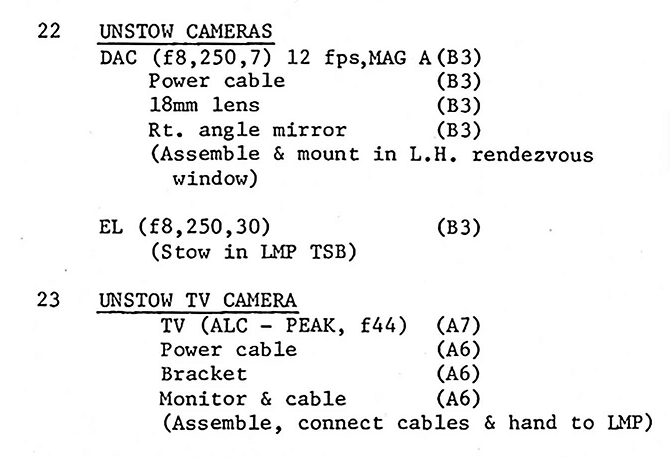
Steps 22 and 23 of the Checklist.
000:52:00 Haise (onboard): I think we ought to be having AOS, gang; we've got...
000:52:02 Lovell (onboard): 56 seconds.
000:52:04 Haise (onboard): Okay. I - Let me call them.
000:52:11 Haise (onboard): Look at me, Jack; I show gain.
000:52:13 Swigert (onboard): You show gain?
000:52:14 Haise (onboard): Yes.
This is Mission Control, Houston at 52 minutes. We're standing by now for Acquisition Of Signal and our Network controller reports we've just reacquired the spacecraft over the Carnarvon station.
000:52:16 Swigert: Houston, how do you read 13?
000:52:20 Kerwin: 13, Houston. Loud and clear.
000:52:23 Swigert: Okay, Joe. Everything is going good. We're proceeding on the time line in good fashion. I've got a P52 done. I can give you the torqueing angles.
000:52:33 Kerwin: I'm ready for them, Jack.
000:52:35 Swigert: Okay. Used Noun 26 - stars 26 and 33. The star angle difference was all balls. Noun 93: minus 067, minus all balls, plus 0.162. The time of torqueing was 45 minutes, 35 seconds.
000:52:59 Kerwin: Ah, well, that sounds marginally acceptable.
000:53:04 Swigert: For a new CMP, it ain't too bad.
000:53:05 Kerwin: Yeah. Okay, 13. We've got nothing for you at the moment. Everything's looking good. We're looking at your data now.
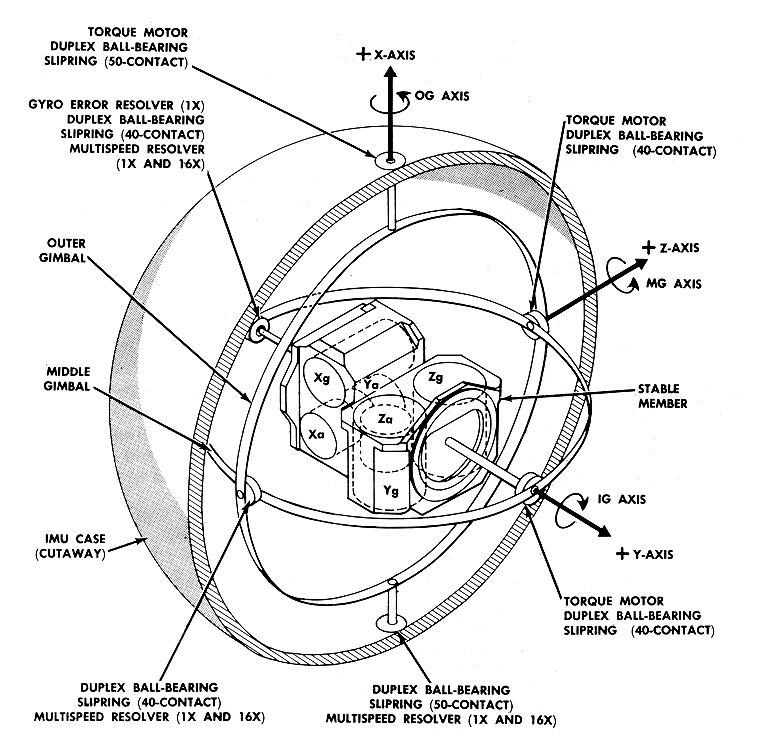
Diagram view of the Inertial Measurement Unit
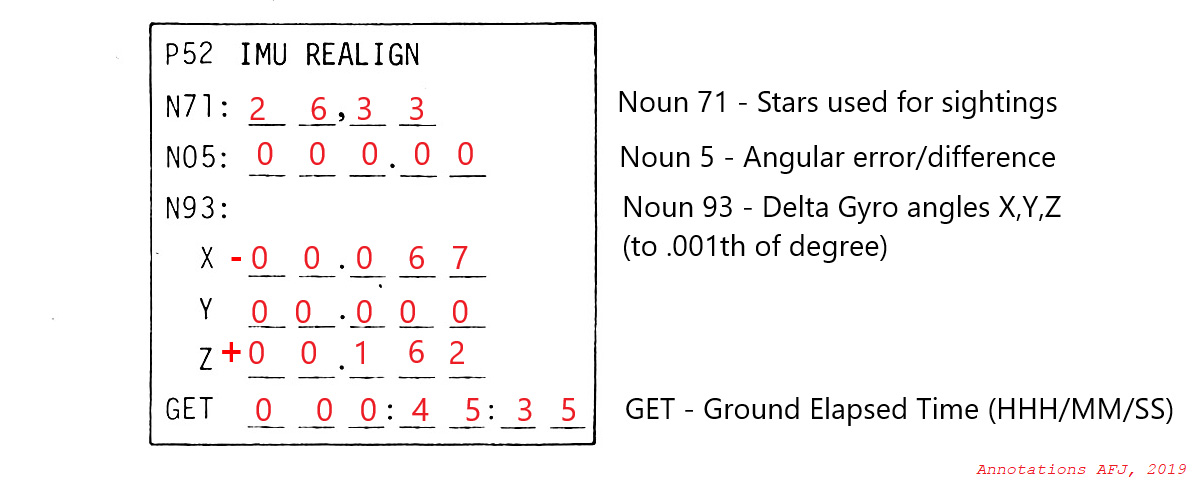
A P52 box from the Flight Plan, annotated with data for the first realignment.
000:54:35 Haise (onboard): How you doing?
000:54:36 Lovell (onboard): I got [garble]. You got to get it when you're going by.
000:54:39 Haise (onboard): Okay.
000:54:40 Swigert (onboard): Yes, I've got - got it in my helmet bag right now.
000:54:43 Lovell (onboard): Oh, okay, good.
000:54:49 Swigert (onboard): Boy, I'll tell you, that really bothers me [garble].
000:54:54 Lovell (onboard): Does it [garble]? Did you put it over far enough?
000:54:57 Swigert (onboard): Yes, that's where it went - when [garble] It's looking good [garble], and I don't think they jettison until [garble].
000:55:05 Lovell (onboard): Oh.
000:55:08 Swigert (onboard): Okay. Now I've got to get the TV camera [garble], Freddo...
000:55:11 Lovell (onboard): Okay.
000:55:12 Swigert (onboard): ...[garble].
000:55:13 Lovell (onboard): You want to hand me that book, and I'll take a look in it.
000:55:15 Swigert (onboard): Yes. And also see if I've - all the things that I've done, [garble], because I haven't checked them off a couple of places.
000:55:29 Swigert (onboard): Hey, Fred, what do you want first, TV camera?
000:55:32 Haise (onboard): Yes. Just one more - Let me get through one more - system.
000:55:39 Swigert (onboard): That's off. That [garble] right down [garble] on the bulkhead.
000:55:43 Haise (onboard): You get done, you're hooking up the cable. You got to do that part, though. We can't [garble] right there.
000:55:48 Swigert (onboard): All right. And I'll verify the CB power is off...
000:55:50 Haise (onboard): [Garble] off.
000:55:53 Lovell (onboard): I'm going to go back into the - [garble], Jack; and look at [garble].
000:55:59 Swigert (onboard): Okay.
000:56:00 Lovell (onboard): [Garble.]
000:56:02 Swigert (onboard): Freddo, you - How about a bracket?
000:56:04 Haise (onboard): Well.
000:56:11 Swigert (onboard): Okay, that's [garble].
This is Mission Control at 57 minutes, 15 seconds. Not much conversation with the crew on this pass over the Carnarvon tracking station. Jack Swigert reported that the platform had been aligned as called for in the Flight Plan. There's not a great deal of activity scheduled in the Flight Plan at this time. Flight Director Milton Windler has checked the status with his flight controllers and CapCom Joe Kerwin will be passing that up to the crew shortly.
000:58:10 Kerwin: Apollo 13, Houston. LOS Carnarvon in about 30 seconds. Honeysuckle on the hour, and verify your S-band is up for Honeysuckle. Over.
000:58:21 Haise: That's verified.
000:58:24 Lovell: And, Houston, we're beginning to see a beautiful sunrise here.
000:58:29 Kerwin: Roger that, Jim.
We've had Loss Of Signal now with the spacecraft through Carnarvon. Apollo 13 will be coming within range of the tracking antennas at the Honeysuckle Creek, Australia station in less then a minute. We'll stand by for reacquiring.
And at 1 hour, 10 minutes into the flight of Apollo 13, we should be reacquiring radio contact with the spacecraft through Honeysuckle Creek momentarily. Recapping briefly the situation during the launch: We had a normal first stage burn. The second stage ignition was normal up through 5 minutes and 30 seconds at which time the inboard engine, engine No.5 shut down early. The center engine had been scheduled to shut down at about 7 minutes, 44 seconds Ground Elapsed Time. The cut-off on the second stage was at about 9 minutes, 48 seconds - about 30 seconds early, and the total excess burn time on the third stage was about 10 seconds. CapCom Joe Kerwin has just put in a call to the crew. We've had Acquisition Of Signal. We'll stand by for conversation with the spacecraft.
001:00:51 Kerwin: 13, Houston through Honeysuckle. [Long pause.]
001:01:10 Kerwin: Apollo 13, Houston through Honeysuckle.
001:01:15 Lovell: Roger, Houston; 13 here. Reading you loud and clear.
001:01:19 Kerwin: Okay. S-band sounds good, Jim.
001:03:21 Haise: [Very weak.] Ah, Houston, 13.
001:03:24 Kerwin: Go ahead, 13.
001:03:26 Haise: Would it be okay if I crank up the FM [garble]?
001:03:37 Kerwin: You're coming in weak. I didn't quite copy it.
001:03:42 Haise: Would it be okay, Joe, if we crank up the FM after we leave Honeysuckle here?
001:03:47 Kerwin: Oh. Stand by on that one. [Long pause.]
001:04:43 Kerwin: 13, Houston.
001:04:46 Lovell: Go ahead, Houston.
001:04:48 Kerwin: What TV was that? [Pause.] Okay, 13...
001:04:55 Haise: Okay, Joe. I just wanted to put on the TV switch at Honeysuckle to tune her up there.
001:05:01 Kerwin: Roger. I'm being prompted, and you've got a Go for that. You can turn it on, go to TV, and we'll see you that way over the States.
001:05:10 Haise: Okay. [Long pause.]
001:05:18 Lovell (onboard): Fred, I'll read the PADs, or you read the PADs, or somebody read the PADs.
001:05:22 Swigert (onboard): Hey, can I get a - a TV [garble]?
001:05:29 Haise (onboard): Oh, yes, Jack. LOS Carnarvon.
001:05:35 Lovell (onboard): Okay. 1:45, 75 [garble] LOS at - [garble].
001:05:36 Kerwin: Okay. 13, Houston. LOS Honeysuckle in about 30 seconds, and we'll see you over the States at 1 plus 28 plus 43. [Long pause.]
001:05:51 Lovell (onboard): Okay, coming up. [garble].
001:05:57 Kerwin: 13, Houston. Did you copy your AOS time?
001:06:07 Lovell (onboard): Fred, I'll get them when we get all relaxed. I'll do that [garble].
001:06:14 Swigert (onboard): [Garble.]
001:06:20 Lovell (onboard): Hey, Jack, [garble].
001:06:25 Haise (onboard): [Garble.]
001:06:33 Swigert (onboard): Yes, I can - yes, I can do it, Freddo. [garble].
We've had Loss Of Signal now from the spacecraft. At last look, everything appeared to be normal with the spacecraft and the launch vehicle. We currently show an orbit of 103.2 nautical miles - actually, a correction on that, 102.6 by 106.3 [nautical miles, 190.0 by 196.9 km] and our current altitude is 103.2 [191.1 km]. We'll be reacquiring the spacecraft over the United States at a Ground Elapsed Time of 1 minute, 28 seconds, 43 - 28 minutes, 43 seconds at which time you heard the crew advise that they will be configured for the TV transmission, which is scheduled to occur at about 1 minute - 1 hour, 36 minutes over the MILA station. The Post Launch Press Conference is scheduled to begin shortly at Cape Kennedy. At 1 hour, 7 minutes; this is Mission Control, Houston.
Chair: Okay, we're back here at Kennedy Space Center now, and I guess we're ready to proceed. We're going to atttempt to conduct this post launch conference between communications with the spacecraft. This gives us approximately some 20 minutes. We'll do our best to try and get as many questions in in that time, but I'll be standing by for a signal also so we can go back to air-ground at the proper time so you can keep up with every phase of the mission. At this point, I'd like to introduce Mr. Walter Kapryan, Director of Launch Operations for the Kennedy Space Center and Launch Director for Apollo missions.
Kapryan: Good afternoon ladies and gentlemen. It's a pleasure to see you on a clear day for a change. I guess there really isn't too much to report to you as far as the countdown itself is concerned. It was perfectly nominal. We had no problems whatsoever with the spacecraft, with one exception and that was in that we do have a lock to safe our pyro bus and it takes a key to remove that lock and we broke the darn key off in the lock and it took us a little while to get it out. We did have a spare key and we took that off. And that's the soil and substance of our problems with the spacecraft. At approximately 1 hour and 50 minutes before launch, we did run into a little difficulty with a LOX vent valve on the S-IC stage which we were attempting to cycle; open and close as required for the venting process, and it stuck on us in the full-open position, and we ran through a repeated number of cycles attempting to free it and for some time were unsuccessful in doing so. It caused us concern in that if we had not been able to close the vent valve, we would not have been able to pressurise the LOX tank at T minus 72 seconds. However, we did run some nitrogen gas through the system and we were able to sufficiently raise the temperature such that we were able to close the valve and we proceeded the rest of the way with that vent valve in a closed position at all times and we do have a second vent valve in the stage that we relied on to give us the correct conditions at time of stage pressurisation at T minus 72 seconds. Those two items were the soil and substance of the problems that we encountered during the entire countdown. As most of you know by this time, the first stage burn was perfectly nominal. You may have noticed that it seemed almost like an eternity before the vehicle cleared the tower. That, of course, was because this is the heaviest vehicle that we've flown. It was approximately 26,000 pounds heavier at lift-off than Apollo 12 and the S-IC engines, though they were perfectly within specification, were rated at about 100,000 pounds total thrust less than those that we had on the Apollo 12 vehicle. This made the time about one half to three quarters of a second longer in clearing the tower. All of the first stage burn, as I mentioned earlier, was perfectly nominal. The second stage burn was nominal up until the time that the S-II inboard engine cut off. That engine is normally cut off by switch selector command approximately 90 seconds before the outboard engines are cut off. For some reeason that we have not been able to determine at this time, the engine did cut itself off approximately 2 minutes earlier than planned. Now, as a result of that having happened, the outboard engines of course burned approximately a half a second [means minute] longer; they burned to fuel depletion and made up some of the energy that was lost by virtue of the inboard engine having cut off early, and when we burned the S-IVB, it burned approximately half a minute longer than originally planned in order to make up the deficiency and at the end of the first burn of the S-IVB, the deficiency was made up. Now, we had approximately 2,200-pound payload margin for this mission. We used up a little but of that margin by the fact that the engine did cut off early but we did not use up enough to - to lose any confidence in our ability to perform the TLI manoeuvre. We do still have a 3-sigma capability. So, we have no reason to suspect that we will not have a good TLI burn and fly a perfectly nominal mission from this point on. I guess that's all I have in the way of general comments. Feel free to ask any questions if you choose to.
Chair: Hey, Dick, right down here.
Newsman: Why did we nominally have main stage engines lower rated in thrust, if I understood you correctly?
Kapryan: They weren't - they weren't - Well, you know, the vendor guarantees engine performance to within cer - to a certain specification. These engines did meet that specification. It just so happens they weren't quite as hot as the ones we flew on Apollo 12. There's nothing wrong with them. I don't - I don't mean to imply that. I'm just explaining to you why it took a little longer to clear the tower than it had taken on previous missions.
Chair: Up there. Go ahead.
Newsman: Does the longer time for the S-IVB burn affect the time lines, or...?
Kapryan: I don't think it affects us significantly. I think we're going to be within seconds. Certainly not more than a minute or two.
Chair: Question Anderson.
Newsman: Do you have that total lift-off weight, since it was the heaviest, other than 26,000 more than the others?
Kapryan: No, I don't. It was - if you recall what Apollo 12 was, add 25,600 pounds to it.
Chair: That was about 6.4 [million pounds] but we'll check that figure for you. Al, up there. Go ahead. Okay. Go ahead. Go ahead, Reg.
Turnill: You told us there was a 22,000-pound payload margin...
Kapryan: 2,200-pound.
Turnill: ...200, thanks. How much of that margin has been consumed, please?
Kapryan: Best we can determine, we used up a significant proportion of that margin. Now, beyond that margin, we still have what we call a 3-sigma capability, so we have the full 3-sigma capability plus somewhat of a margin. Now, at the time I left the firing room, we did not have all of the numbers in yet, telling us exactly how much we had but we did - were able to establish that we still had - we did have the full 3-sigma margin. The 2,200 pounds was something that was a little bit of gravy that we had in addition to that.
Turnill: And is it a fact that you've just got enough for TLI now?
Kapryan: Yes. For a 3-sigma condition. In other words, for a worst-case condition. If you put all of your 3-sigma errors together, which is the basis on which we plan our missions, we have enough reserves to handle that.
Turnill: Thank you.
Unknown speaker: We use - we still have margin. We still do have - we have all the margin we wanted to have. We've not used up all our margin or even come close to using it up.
Kapryan: We have our full 3-sigma margin.
Chair: [Garble].
Newsman: On that - on that weight again, what - where are you getting the extra 22,000 pounds? Is that fuel, and if so, located where?
Kapryan: The - as far as the margin itself was concerned, well, we flew - we flew with some extra propellants aboard this vehicle. Part of it for the reason of flying this missions and part of it to just get a little bit of added knowledge in - as a preliminary to flying the 'J' missions which are going to be missions where we fly with heavier payloads than we've been flying to this time. So we loaded the tanks up more than was required to fly the mission.
Chair: Go ahead, [garble].
Newsman interjection: Does that include...
Newsman: Do you have enough fuel left for the - to guide the S-IVB for the lunar impact?
Kapryan: I asked that question when I left the firing room. The best answer I could get at that time was that we should not affect our capability of flying the nominal lunar impact with the S-IVB. In other words, we expect to impact the S-IVB where we planned to.
Chair: Ed. Over here.
Newsman: Why that's the same question I wanted to ask.
Chair: Have any over here? Okay, any more hands? Okay, we'll take two over here and then we'll wrap it up.
Newsman: [Garble], Mattingly was in the control room. Was there no concern about his being infectious with German Measles?
Speaker: He was in the control room in Houston.
Kapryan: Mattingly left the cape last night.
Chair: I think we'd have to - We'll try to find that out for you, Ben, but I don't think we have any details. Ken Mattingly observed the launch from the Mission Control Center in Houston, not here. If you have a question, Andy, go ahead.
Newsman: Could you give us the figures again for the additional burn of the S-II and the S-IVB?
Kapryan: Yes, the S-II inboard engine, the center engine cut off 2 minutes and 7 seconds earlier than it was supposed to. As a result of that, the outboard engines burned 33.96, roughly 34 seconds longer than they would have had the inboard engine burned for its proper time. As far as the S-IVB is concerned, the delta in time was about the same; 33.97, roughly 34 seconds longer.
Chair: Okay, we'll take one here.
Newsman: One last thing about this extra fuel, Walt. Did you have extra fuel in the S-IVB by any chance, as a result of running this weight up and did that give you a little more leeway?
Kapryan: Yes, we had some extra fuel in all three stages. We had about the same amount of LOX that we flew on Pete Conrad's mission. We had approximately 9,500 pounds more RP-1 than we had on Apollo 12, and we had more LOX and hydrogen on both the other stages. I knew those figures but I've forgotten them. I can't give them to you.
Newsman: Did that make any difference in the 3-sigma?
Kapryan: Well, it helped us out.
Newsman: Okay.
Chair: All right, we'll take one final one up here.
Newsman: Can we have exact lift-off time please?
Kapryan: Let me check here. Here it is. It was 600 milliseconds late. 2:13.00.6
Chair: Okay, thank you very much. That completes the conference. We should be coming back up on acquisition in about 10 minutes.
Kapryan: [Mumbling to PAO.] There's one thing I said that I'm not sure I knew [garble] what it does to the time line...
This is Apollo Control at 1 hour, 28 minutes. We'll be re-establishing radio communications with Apollo 13 in about 40 seconds as the spaceship comes within range of the Guaymas, Mexico tracking station. During the launch phase, the medic reports the following heart rates. These are maximum heart rates for the three crewmen. Commander Jim Lovell had a maximum heart rate during the launch of 116; the Command Module Pilot Jack Swigert had a maximum heart rate of 102; and the Lunar Module Pilot Fred Haise also had a maximum heart rate of 102.
001:28:40 Kerwin: Apollo 13, Houston through Guaymas. Over. [No Answer.]
CapCom Joe Kerwin has just put in a call to the crew through Guaymas. We'll stand by.
001:29:31 Kerwin: Apollo 13, Houston through Guaymas. Over. [No Answer.]
001:29:55 Kerwin: Apollo 13, Houston. [No Answer.]
001:30:28 Kerwin: Apollo 13, Houston. Over. [No Answer.]
001:30:48 Kerwin: Apollo 13, Houston. Over. [No Answer.]
001:31:07 Kerwin: Apollo 13, Houston. Over.
001:31:09 Swigert: Go ahead.
001:31:10 Kerwin: Hello there. We thought you were still up there.
001:31:13 Swigert: And we're just coming up on Baja, and I've got the TV on. Do you want it?
001:31:18 Kerwin: I don't think we require it just yet, Jack, but we'll command it when we're ready. I believe they are dumping the tape now. The booster looks good. The spacecraft looks good on the few minutes' data we've had.
001:31:31 Swigert: That sounds good.
001:31:40 Swigert: Jim finally let me look out.
001:31:41 Kerwin: (Laughter) How do you like it? [Pause.]
001:31:52 Swigert: Chained me to the LEB down there stowing things and unstowing things, and I finally got a chance to look out and see the world. [Long pause.]
That was Jack Swigert reporting, apparently his first view out the windows.
001:32:16 Kerwin: Apollo 13, Houston. I have the TLI plus 90, and lift-off plus 8 PADs whenever you're ready. [Long pause.]
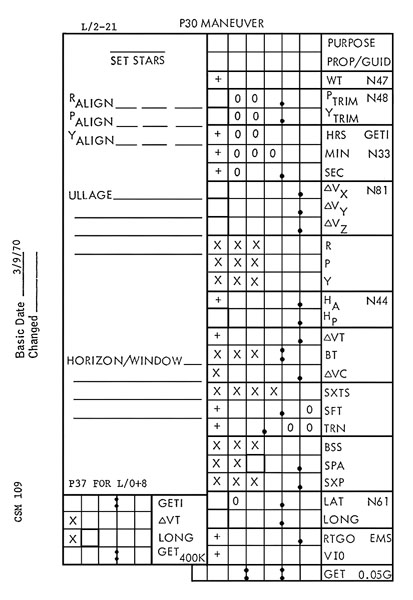
Pre-prepared table for filling in the TLI plus 90 PAD, from Launch Checklist.
001:32:35 Swigert: Okay. Go ahead with the TLI PAD, Joe.
001:32:41 Kerwin: Okay. This is the TLI plus 90 PAD. SPS/G&N, 63825, minus 1.54, plus 1.32, 004:06:45.53, minus 0491.7, plus 0000.1, plus 6634.0, 180, 228, 001; H
A is N/A; H
P is plus 0017.9; 6652.2, 7:37, 6626.5, 26, 155.4, 15.7. Boresight star is Zeta Sagittarii; up, 08.0; right, 2.1; minus 22.81, minus 025.00, 1140.7, 34087, 013:32:14. Set stars; Arcturus, Denebola; roll, 044; pitch, 012; yaw, 025; no ullage. Over.
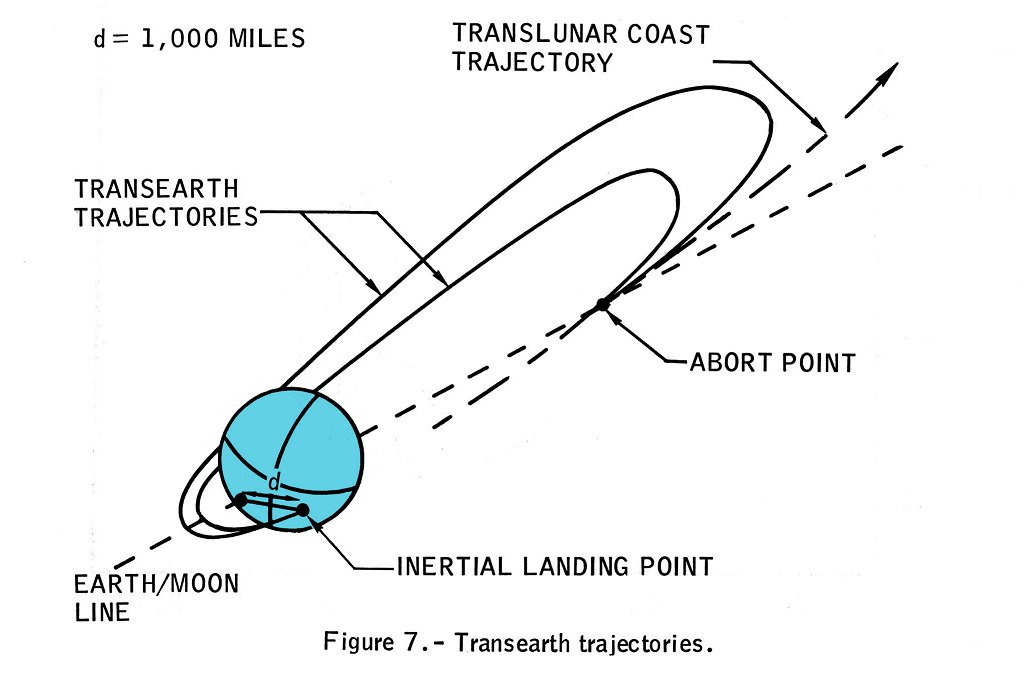
Translunar abort geometry.
001:34:41 Swigert: Joe, we had a dropout of signal there about midway or about a fifth of the start of your PAD, and Fred didn't get it. We'd like you to start over again. Could you please?
001:34:52 Kerwin: Sure thing. You want the whole thing?
001:34:54 Swigert: Yes, I think you'd better.
001:34:56 Kerwin: Okay. TLI plus 90: SPS/G&N, 63825, minus 1.54, plus 1.32, 004:06:45.53, minus 0491.7, plus 0000.1, plus 6634.0, 180, 228, 001; N/A; plus 0017.9, 6652.2, 7:37, 6626.5, 26, 155.4, 15.7; Zeta Sagittarii; up, 08.0; right 2.1; minus 22.81, minus 025.00, 1140.7, 34087, 013:32:14. Set stars: Arcturus, Denebola; roll, 044; pitch, 012; yaw, 025; no ullage. Over.
001:36:47 Haise: Okay, Joe. That's 63825, minus 1.54, plus 1.32, 004:06:45.53...
001:37:02 Kerwin: Fred, Houston. Stand by 1.
001:37:04 Haise: ...minus 0491.7, plus 0000.1, plus 6634.0.
001:37:12 Kerwin: Fred, Houston. Over.
001:37:13 Haise: Go ahead.
001:37:15 Kerwin: That's correct. We'd like you to go the S-Band Aux TV switch to TV, please.
001:37:22 Haise: Okay. It's set to TV.
001:37:23 Kerwin: Okay. We're not getting a signal.
001:37:25 Swigert: Okay. I'll go to Transmit, Joe.
001:37:26 Kerwin: Okay. You can continue reading back.
001:37:31 Haise: Okay. Roll, 180; pitch, 228; yaw, 001; N/A; plus 0017.9, 6652.2, 7:37, 6626.5 and I missed sextant shaft; - trunnion - trunnion, 15.7, Zeta Sagittarius, up, 08.0; roll 2.1; minus 22.81, minus 00 - correction, minus 025.00, 1140.7, 34087, 013:32:14. Set stars: Arcturus and Denebola; roll align, 044; pitch, 012; yaw, 025; no ullage.
001:38:31 Kerwin: Roger, Fred. Readback correct. The sextant star is 26, and the shaft is 15.54. Over.
001:38:42 Haise: Okay. Sextant star 26 and 15.54.
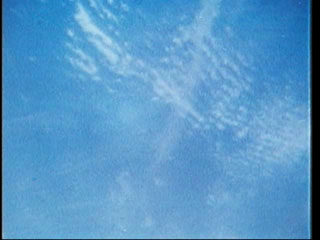
First TV image from Apollo 13 orbiting the Earth.
001:38:46 Kerwin: Roger. And we have a picture now; however, it's moving around quite a bit, if you could hold the camera a little steadier. And I have your...
001:38:54 Haise: ...Okay, Joe. There's nothing but clouds outside, and when we get some land down there coming up, I'll switch back to the window, I thought I'd just show you Jim here, to make sure he's still here.
001:39:08 Kerwin: Okay; real fine. We had a good picture of Jim there for a minute. I have the Lift-off plus 8 PAD, Fred. If you're ready.
001:39:17 Haise: Go ahead, Joe.
001:39:18 Kerwin: Okay. GET
I, 008:00; Delta-V
T, 7835; longitude, minus 165; GET 400K, 022:36. Over.
001:39:41 Haise: Okay. 008:00, 7835, minus 165, 022:36.
001:39:49 Kerwin: Okay, then. And I have TLI PAD for you.
001:39:54 Haise: Okay. I'm ready.
001:39:55 Kerwin: TLI: 2:26:05, 179, 108, 000, 5:47, 10416.9, 35587, 358, 139, 320, 302, 319, 040. Ejection time, 4 plus 01 plus 00. Over. [Pause.]
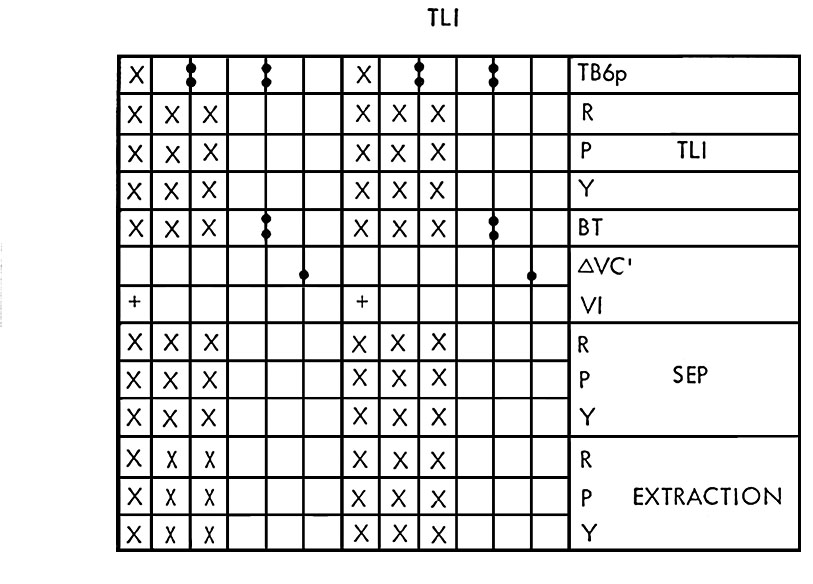
TLI PAD from the Launch Checklist.
001:40:44 Haise: Okay. TLI: 2 plus 26 plus 05, 179, 108, 000, 5 plus 47, 10416.9, 35587, 358, 139, 320, 302, 319, 040, and ejection time, 4 plus 01 plus 00.
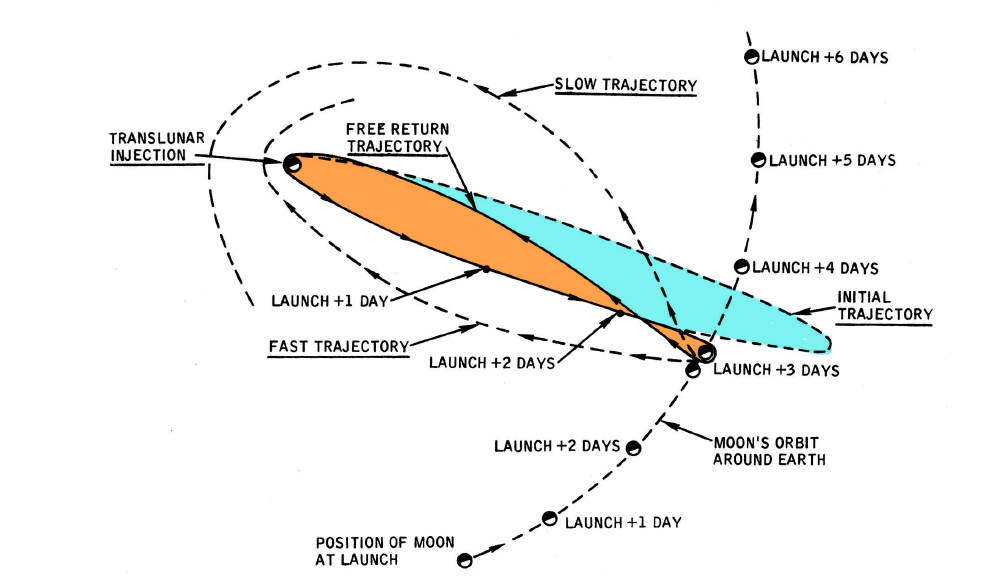
Apollo 13's planned trajectory.
001:41:18 Kerwin: Roger, Fred. Readback correct, and we're getting a nice color TV picture now. If you have any commentary to go with it. [Pause.]
001:41:31 Swigert: Okay, Joe. I'll tell you, I'm just trying to figure out where we are here.
001:41:40 Kerwin: That's your job, not mine.
001:41:43 Swigert: [Garble]. You know, I've just been up out of the LEB for a short time here, and I'm trying to find out which country we're over.
001:41:52 Lovell: I have to keep telling Jack that the blue stuff down there is water.
001:41:56 Kerwin: I'll give you a hint. You're in the western hemisphere. [Long pause.]
001:42:10 Swigert: Okay, Joe. It appears like that we've crossed out into the Gulf of Mexico here, and I've got a peninsula or an island that's down there. I don't know whether you can see it. [Long pause.]
001:42:34 Kerwin: Roger, Jack. We see that. Of course, there's a lot of cloud cover and you see it more clearly than we do, but it does look like the Earth, not the Moon. [Long pause.]
001:42:58 Kerwin: Apollo 13, Houston. We've had LOS MILA now. Thank you very much. [Long pause.]
Off the southern coast of the United States, but we'll stay with it and perhaps we'll get a picture in a moment or so.
001:43:48 Kerwin: Apollo 13, Houston. Request P00 and Accept for a state vector. Over.
001:43:53 Lovell: Roger, Houston. We're in P00 and Accept.
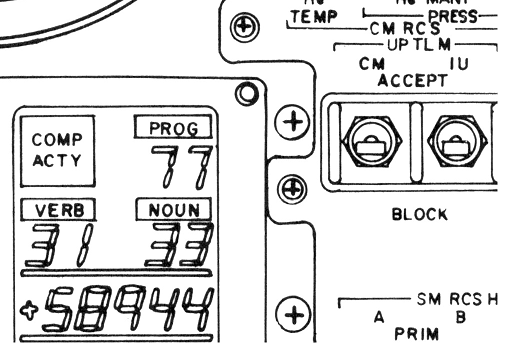
UP TLM switches on the Main Display Console. Scan via heroicrelics.org

Final steps of the Insertion and Systems Checklist.
001:48:08 Kerwin: Apollo 13, Houston.
001:48:10 Lovell: Go ahead, Houston.
001:48:11 Kerwin: Okay. The computer is yours, Jim.
001:48:14 Lovell: Thank you, [garble].
001:48:16 Kerwin: And you are Go for TLI. Huntsville reports that you have a 6-second propellant pad which is 3 seconds more than a 3-sigma case; so you're good on consumables. The IU is so good that we're not going to update it. The only change we have for you is in the TLI checklist. At 57 minutes, where you slew the FDAI to 18 degrees, we recommend 20 degrees there, and we recommend that you look for 8 degrees instead of 6 degrees at ignition. The S-IVB is riding on the top of its deadband.
001:48:56 Lovell: Understand; and just out of curiosity, was that engine-out to use up more S-IVB fuel?
001:49:03 Kerwin: The engine-out did cause you to use more S-IVB fuel - about a 10-second-longer burn; but you're still Go.
001:49:12 Lovell: Okay. Thank you. [Pause.]
001:49:21 Kerwin: And, 13, Houston. We're ready to support pyro arm and docking probe extension whenever you're ready. [Pause.]
001:49:36 Lovell: Okay, Houston. Docking probe has been extended and all indications are nominal. We're down to Pyro Arm now and we're getting ready.
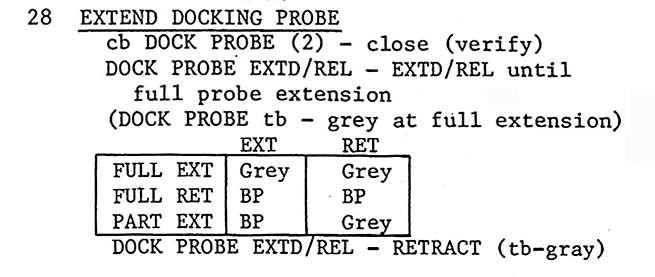
Step 28 - Docking Probe Extend
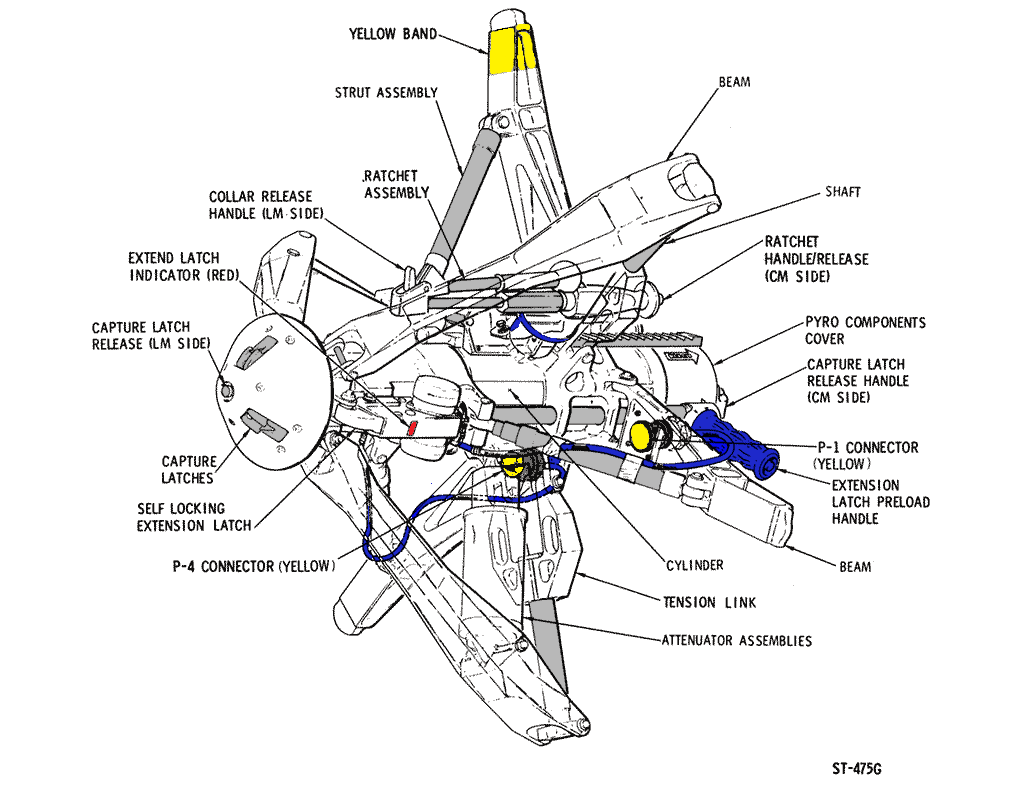
A diagram view of the Docking Probe
001:49:47 Kerwin: Okay, Jim. [Pause.]
001:49:58 Lovell: Okay, Houston. My circuit breaker's armed - or closed; Sequential Logic, two, on and up and we're standing by [garble].
001:50:06 Kerwin: Okay, 13. You're Go for pyro arm. [Long pause.]
We've Loss Of Signal now with the spacecraft through the Vanguard Tracking Ship; we'll be reacquiring at Canary Islands in just a few minutes.
001:50:40 Lovell: And, Houston, 13. Were you reading us?
001:50:43 Kerwin: Roger, 13. Go ahead.
001:50:47 Lovell: Roger. We have our Sequential Arm circuit breakers in and our Sequential Logic, two, on and up and we are just standing by for your confirmation for a Go.
001:50:56 Kerwin: Sorry, 13. You didn't copy. You are Go for pyro arm. Over.
001:51:00 Lovell: Okay; fine. Thank you.
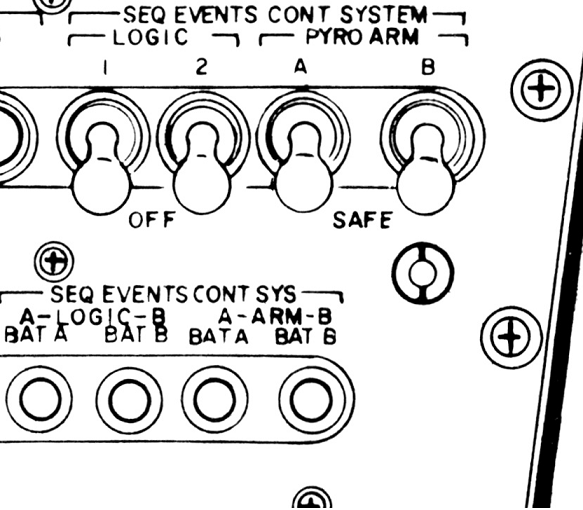
Sequential Events Control System switches on the left hand panel in the CM. Scan via heroicrelics.org
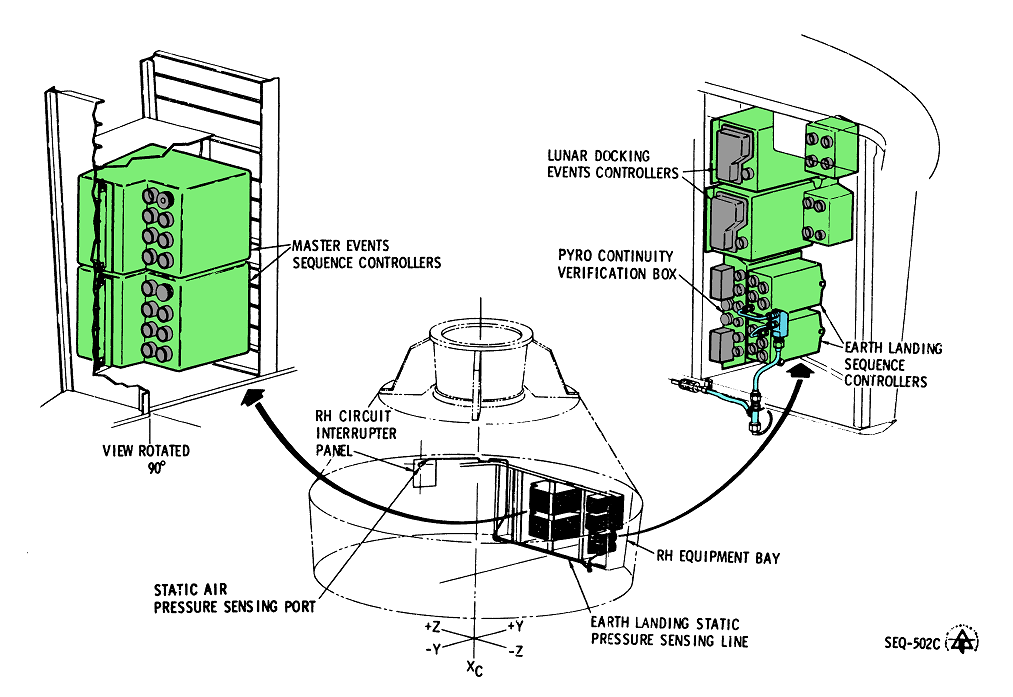
Locations of the various SECS electronics boxes in the Command Module.
001:53:21 Kerwin: Apollo 13, Houston.
001:53:24 Lovell: Go ahead, Houston.
001:53:26 Kerwin: About 2½ minutes to LOS, Jim, and your AOS at Carnarvon will be 2 plus 25 plus 50. Over. [Pause.]
001:53:41 Lovell: Roger. AOS at Carnarvon 2 plus 25 plus 50.
001:53:45 Kerwin: That's affirm.
001:55:57 Kerwin: Apollo 13, Houston. LOS in about 1 minute. At LOS we'd like Command Reset and then Normal.
We've lost contact now with the spacecraft through the Canary Islands Tracking Station. We'll be reacquiring in a little less than 30 minutes, at a Ground Elapsed Time of 2 hours, 26 minutes; when the spacecraft comes within range of the tracking antennas at Carnarvon Australia. During the pass over the United States, and out over the Atlantic, CapCom Joe Kerwin gave the crew a preliminary go ahead for Translunar Injection. We have adequate propellant margins on the Saturn third stage, and despite the some 10 seconds of additional burn in getting into orbit due to the early shutdown of the second stage center engine. It is not expected that the somewhat later injection time will have any significant effect on the Flight Plan; the preliminary time for the beginning of the Translunar Injection burn is 2 hours, 35 minutes, 27 seconds. The Flight Dynamics Officer is in the process now of updating that time but we don't expect a significant change. At 1 hour, 57 minutes, 55 seconds; this is Mission Control, Houston.
This is Apollo Control at 2 hours, 25 minutes. Apollo 13 is now about 10 minutes away from the scheduled ignition of the S-IVB engine to start the spacecraft on its way to the Moon. The Flight Dynamics Officer advises that the planned time for the beginning of that burn will be 2 hours and 35 minutes, 44 seconds Ground Elapsed Time. Our network controller reports that we've just had Acquisition Of Signal with the spacecraft from Carnarvon and during this pass, flight controllers will be looking at the spacecraft and the launch vehicle - the S-IVB - one last time before Translunar Injection.
002:25:38 Kerwin: Apollo 13, Houston through Carnarvon.
002:25:41 Swigert: Okay, Joe. Read you loud and clear. We're sitting here monitoring time base 6. You can see countdown; we're 20 seconds away.
002:25:49 Kerwin: Okay. We're just starting to get data, and everything still looks good to us.
002:25:53 Swigert: Hey, Joe. At 2 hours and 12 minutes, the O
2 Flow High light came on, and it's been pegged high ever since, so it's been on about 14 minutes now.
002:26:04 Kerwin: Roger, 13. We're looking at it.
002:26:09 Lovell: Time base 6.
002:26:12 Kerwin: Copy. Time base 6. [Long pause.]
002:26:52 Kerwin: Okay. Apollo 13, Houston. You have a Go for all systems, and the O
2 Flow High check is nominal with the Waste Tank Vent open at this time, and it's no sweat.
002:27:05 Swigert: Okay. Just wanted you all to check it for me.
002:27:08 Kerwin: Okay. We did.
002:27:11 Swigert: Thank you.
The crew is rather quiet at this time, preparing for that Translunar Injection burn. The burn again scheduled to begin at 2 hours, 35 minutes, 44 seconds. The predicted duration of the burn is 5 minutes, 47 seconds and we expect that the spacecraft and S-IVB will accelerate some 10,417 feet per second [3,175 m/s] as a result of that maneuver. We will not get data from the burn and we'll be out of acquisition with the spacecraft at the time the maneuver occurs. Three ARIA aircraft, Apollo Range Instrumented Aircraft, are stationed in the ground track off the coast of Australia underneath the point on Earth where the Translunar Injection burn will be occurring. They'll be recording data from it which we could play back somewhat later if necessary. The booster engineer's just reported that the S-IVB chilldown in preparation for the burn has begun.
002:31:22 Kerwin: Apollo 13, Houston. We'll be losing data from Carnarvon in about 1 minute. We'll probably have voice through ARIA. Everything is hunky-dory, and we'll be listening for you to tell us how the burn goes.
002:31:34 Lovell: Okay, this is 13. We're standing by, too.
We've had Loss Of Signal now through Carnarvon. And CapCom Joe Kerwin has just put on a call through one of the ARIA aircraft.
002:33:14 Kerwin: Apollo 13, Houston through ARIA. Just a comm check. Over.
002:33:20 Lovell: Reading you clear [garble].
002:33:26 Kerwin: Okay, Jim. It's not the best, but we're reading you.
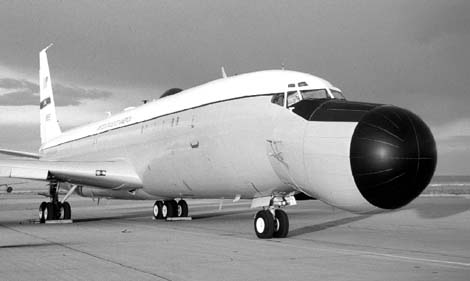
ARIA aircraft.
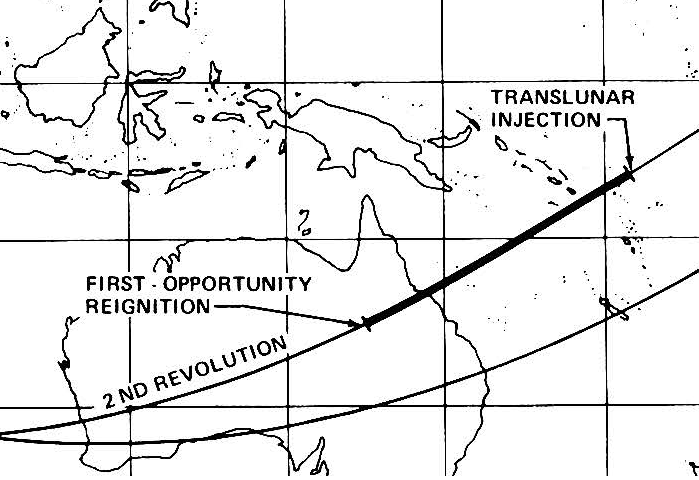
Map of the land track of the Translunar Injection, from pre-mission Saturn V flight manual.
We expect communications will continue to be somewhat noisy during the time that conversation from the spacecraft is being relayed through the ARIA aircraft. As mentioned before, we will not see the telemetry data on the burn. We do hope to get voice reports on the progress of the maneuver from the crew. We are now just a little more than one minute away from the scheduled beginning of that burn.
002:34:28 Swigert (onboard): [Garble] now?
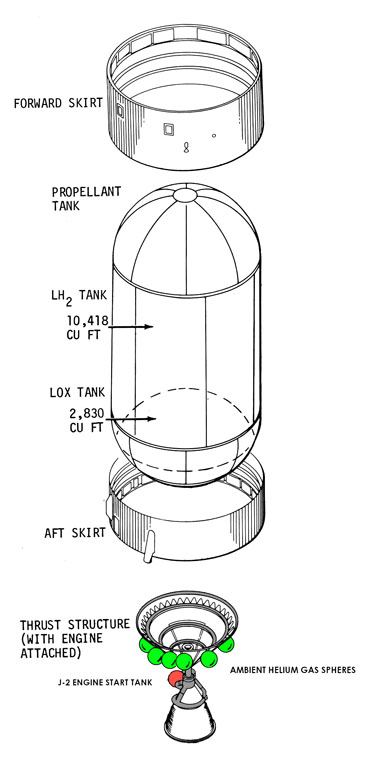
The placement of the ambient helium spheres at the base of the S-IVB.
002:34:30 Haise (onboard): [Garble.]
002:34:32 Swigert (onboard): [Garble] 59 - [garble].
002:34:49 Lovell (onboard): What was this [garble]?
002:34:52 Haise (onboard): [Garble.]
002:34:58 Swigert (onboard): [Garble] and what are your FDAI angles [garble]?
002:35:01 Lovell (onboard): [Garble.]
002:35:03 Swigert (onboard): Okay, 59 ...[garble]?
002:35:05 Lovell (onboard): [Garble.]
002:35:11 Swigert (onboard): Okay, I've got 59 and 30. How's that? Okay?
002:35:27 Swigert (onboard): [Garble] the burn, [garble].
002:35:29 Lovell (onboard): [Garble.]
002:35:34 Swigert (onboard): Okay. [Garble] burning, Jim.
002:35:37 Lovell (onboard): Okay. Here, I'll get out the [garble].
002:35:40 Swigert (onboard): [Garble.]
002:35:45 Haise (onboard): [Garble.]
002:35:46 Swigert (onboard): Burning!
002:35:48 Lovell (onboard): Okay. Watch that...
002:35:51 Lovell: Ignition, Houston.
002:35:53 Kerwin: Copy that, Jim. Good deal.
002:35:56 Swigert (onboard): Okay. [Garble] pitching her down a little bit, right here.
Jim Lovell reports that we have ignition.
002:36:00 Lovell (onboard): [Garble.] There you go.
002:36:04 Swigert (onboard): [Garble.] Is that all right?
002:36:05 Lovell (onboard): Okay, you watch the - trajectory thrust?
002:36:09 Swigert (onboard): Yes.
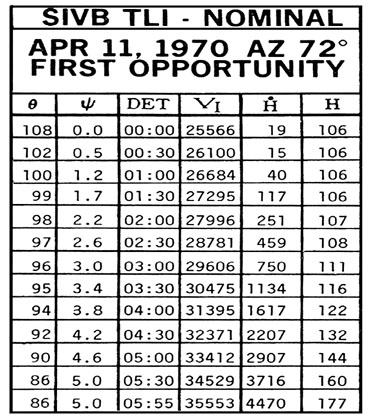
Translunar Injection Burn Monitoring Card
Lovell's report would indicate we had a very close to on-time ignition. A total burn duration should be about 5 minutes, 47 seconds.
002:36:25 Swigert (onboard): [Garble] burned 14-second velocity V
I and [garble].
002:36:46 Lovell (onboard): [Garble]?
002:36:47 Swigert (onboard): It's right on V
I; we're right on V
I.
002:36:55 Lovell (onboard): Got both [garble] up?
002:36:58 Haise (onboard): We got to leave these open.
002:37:06 Swigert (onboard): Okay, 01:30. Three minutes and...
002:37:07 Haise (onboard): 0.75.
002:37:09 Swigert (onboard): [garble].
002:37:17 Swigert (onboard): Right on - right on; [garble] little bit higher [garble].
002:37:30 Lovell (onboard): [Garble.]
002:37:35 Swigert (onboard): [Garble.]
002:37:37 Lovell (onboard): Watch the [garble].
002:37:44 Haise (onboard): Okay, Jim, it's 2 minutes [garble].
002:37:52 Lovell: Everything's okay so far.
002:37:56 Kerwin: Houston; Roger. [Long pause.]
002:38:06 Swigert (onboard): Okay; we got 02:30 coming [garble], Jim?
Jim Lovell just reported that everything looks good with that burn. We're still about 7 minutes away from reacquiring the spacecraft through the station in Hawaii at which time we'll get our first good look at the trajectory as a result of this burn.
002:38:17 Swigert (onboard): Right on [garble]. Right on H-dot; we're right on 8.
002:38:27 Lovell: They are off - at 38.
002:38:31 Swigert (onboard): Three minutes...
002:38:47 Swigert (onboard): [Garble.]
002:38:48 Lovell (onboard): All right.
002:39:02 Swigert (onboard): 3:30, Jim. 3.4.
002:39:06 Lovell (onboard): 3.4. Okay.
We're now 3½ minutes into the Translunar Injection burn. Some 2 minutes, 17 seconds remaining in the maneuver which will start Apollo 13 en route to the Moon.
002:39:17 Swigert (onboard): Okay. We're right on.
002:39:19 Lovell (onboard): Okay. [Garble].
002:39:27 Swigert (onboard): Okay, at 4 minutes. [Garble].
002:39:36 Haise (onboard): [Garble]?
002:39:38 Lovell (onboard): Okay.
002:39:42 Lovell (onboard): Okay, we'll hold this down; we've got a little vibration.
002:39:45 Haise (onboard): [Garble].
002:39:47 Lovell (onboard): Yes.
002:39:57 Lovell (onboard): No, [garble] thousand, 200 [garble].
002:40:06 Multiple speakers (onboard): [Garble].
002:40:07 Swigert (onboard): We're looking at 4 point [garble]...
002:40:09 Lovell (onboard): 4 point [garble], okay.
002:40:16 Swigert (onboard): Right on at 30. A little bit high.
002:40:26 Lovell: And, Houston, we're noticing a little vibration during this burn.
002:40:28 Kerwin: Houston; Roger.
002:40:37 Haise (onboard): Five minutes [garble] 4.6.
002:40:41 Lovell (onboard): Okay.
002:40:46 Swigert (onboard): [Garble] a hundred [garble].
002:40:50 Lovell (onboard): Okay.
002:40:51 Swigert (onboard): H-dot is a little high [garble].
002:40:54 Lovell (onboard): Okay.
002:40:59 Haise (onboard): 5:30 - 5 point - [garble] the same countdown, Jack, and then start counting up.
002:41:06 Swigert (onboard): Okay.
002:41:07 Haise (onboard): [Garble.]
002:41:08 Swigert (onboard): [Garble] V
I [garble].
Now about 20 seconds away from the scheduled shutdown time. Jim Lovell reported a few moments ago that that they're experiencing a bit of vibration on the S-IVB. Previous crews have also reported similar experience toward the end of the burn.
002:41:11 Lovell (onboard): [Garble.]
002:41:15 Haise (onboard): Five seconds.
002:41:16 Swigert (onboard): Five [garble], okay.
002:41:19 Lovell (onboard): Better get [garble].
002:41:22 Swigert (onboard): 5.0. [Garble.]
002:41:28 Lovell (onboard): 5...
002:41:29 Haise (onboard): 4, 3, 2, 1 - 1, 2, 3, 4...
002:41:34 Haise (onboard): Okay.
002:41:38 Lovell (onboard): Engine Off. [Garble].
002:41:39 Haise (onboard): [Garble] is three-quarter overburn.
002:41:40 Lovell: It's off. Engine off.
002:41:42 Kerwin: Houston. Copy. Engine off. [Long pause.]
002:41:44 Haise (onboard): Freeze the DSKY.
002:41:45 Swigert (onboard): I did.
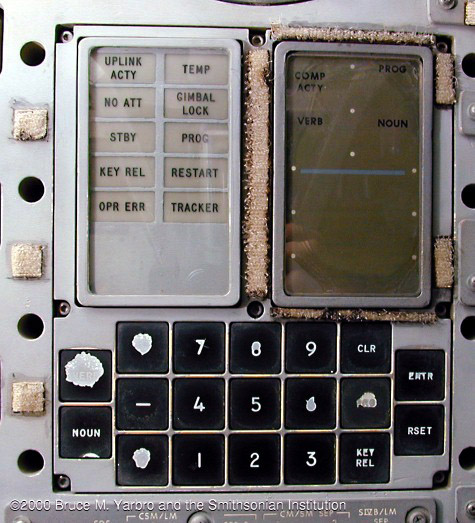
The DSKY photographed onboard the Odyssey.
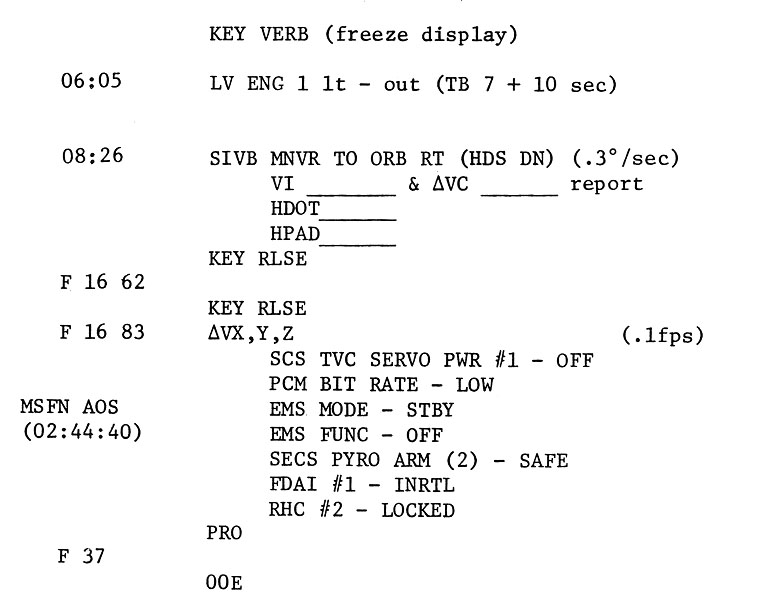
Post-TLI checklist
002:41:46 Haise (onboard): Okay, and now we'll [garble].
002:41:49 Haise (onboard): Okay, Jim, it's SCS TVC Servo Power 1, Off.
002:41:52 Lovell (onboard): It's Off.
002:41:53 Haise (onboard): PCM Bit Rate, I got Low. EMS Mode - Wait, let Jack get it. Minus 3.0.
002:41:57 Swigert (onboard): Boy, beautiful.
002:41:58 Haise (onboard): You got that, Jack?
002:41:59 Swigert (onboard): Yes.
002:42:00 Haise (onboard): EMS Mode to Standby?
002:42:01 Swigert (onboard): [Garble.]
002:42:03 Lovell (onboard): EMS Mode to Standby.
002:42:04 Haise (onboard): Standby. Function, Off.
002:42:06 Lovell (onboard): Function, Off.
002:42:07 Haise (onboard): Sequence Pyro Arm, two, Safe.
002:42:08 Lovell (onboard): Sequence Pyro Arm, two, Safe.
002:42:09 Swigert (onboard): That's a [garble], too.
002:42:12 Lovell (onboard): Okay.
002:42:13 Haise (onboard): Okay. Sequence - FDAI 1, Inertial.
002:42:18 Lovell (onboard): FDAI 1 going Inertial.
002:42:20 Haise (onboard): And lock your hand controller.
002:42:22 Lovell (onboard): Hand controller is locked.
002:42:24 Haise (onboard): Okay, Jack, you clean up the DSKY and eventually get the P00.
Lovell's report of engine-on came about five or six seconds after the preplanned time.
002:42:27 Kerwin: 13, Houston. We'll have you through Hawaii in 3 minutes.
002:42:31 Lovell: Roger. Through Hawaii in 3 minutes.
002:42:33 Haise (onboard): Okay.
002:42:34 Swigert (onboard): Okay...
002:42:35 Haise (onboard): So we're standing by until Jack gets through that - jazz...
002:42:38 Lovell (onboard): How does that look, Jack?
002:42:40 Swigert (onboard): Looks good.
002:42:45 Haise (onboard): Okay, it's a Verb 66 Enter, Jack, after you get - after you get the P00. Wait until you get that.
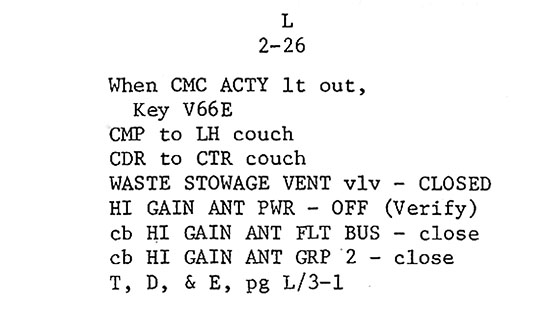
Second half of the post-TLI checklist
Our communications continuing to come to us relayed through the ARIA aircraft. CapCom Joe Kerwin advised Lovell and the Apollo 13 crew that we'll be reacquiring a little less than three minutes from now through Hawaii at which time we should get good solid S-band communications and also our first look at the trajectory of Apollo 13 following the burn.
002:42:52 Swigert (onboard): [Garble.]
002:42:57 Haise (onboard): Okay, now you all switch -
En route, Jack, you got to do a couple of things.
002:43:07 Lovell (onboard): In Hawaii, we'll get their [garble]...
002:43:12 Swigert (onboard): Okay. You - let me put this - put this up under here...
002:43:17 Haise (onboard): Okay.
002:43:18 Lovell (onboard): And we'll have to switch comm carriers so I can take this suit stuff off.
002:43:20 Haise (onboard): Yes. We'll have to take the suit power off.
002:43:23 Lovell (onboard): Yes. And we'll...
002:43:24 Haise (onboard): And what would be nice for you to do, Jack, if you can...
002:43:27 Swigert (onboard): Okay. What do you want me to do?
002:43:28 Haise (onboard): ... is, first of all, Waste Stowage Vent valve, Closed.
002:43:30 Swigert (onboard): Okay. I'll do that right now.
002:43:38 Haise (onboard): I've got the High Gain Power, Off, and I'm getting - I've got those two breakers in on 225. Waste Stowage Vent valve is Closed.
002:43:44 Swigert (onboard): Closed.
002:43:45 Haise (onboard): Now, get the TV camera out from under there, will you?
002:43:47 Swigert (onboard): Okay.
002:43:48 Haise (onboard): And I'll be dickering with that...
002:43:51 Swigert (onboard): [Garble]...
002:43:52 Haise (onboard): [Garble.]
002:43:54 Swigert (onboard): TV camera's...
002:43:57 Haise (onboard): Thank you. May as well get me the monitor and all that jazz.
002:44:00 Swigert (onboard): I'll go do that now.
002:44:02 Haise (onboard): And the bracket. I'll be fiddling and getting this baby ready.
002:44:06 Swigert (onboard): One bracket.
002:44:08 Haise (onboard): Thank you.
Our communications is getting quite noisy at this point through the ARIA relay. Lovell's reports of ignition and engine shutdown would indicate that the burn went at least fairly close to nominal. He reported engine shutdown about six seconds following the time that the engine was scheduled to shut down. And we'll be reacquiring at Hawaii in about 45 seconds.
We have had Acquisition Of Signal at Hawaii, we'll stand by for a call to the crew.
002:44:27 Swigert (onboard): Okay, Freddo, now here's the monitor.
002:44:37 Haise (onboard): Okay. Got a - Thank you. Okay. [Garble.]
002:44:53 Haise (onboard): Okay. Okay. The [garble] are off - done.
002:45:14 Lovell (onboard): Stand by. [Garble].
002:45:21 Swigert (onboard): It's funny.
002:45:25 Lovell (onboard): Okay, my Suit Power's going Off...
002:45:29 Lovell (onboard): ...[Garble] you got comm...
002:45:30 Kerwin: Apollo 13, Houston through Hawaii. Over.
002:45:32 Lovell (onboard): Roger, Houston.
002:45:34 Lovell: 13 through Hawaii. How do you read?
002:45:38 Kerwin: 13, Houston. You're weak but clear; it'll probably get better in a second. We're standing by for the burn report.
002:45:42 Lovell: Roger. [Long pause.]
002:45:43 Lovell (onboard): Jack, we need the burn report just briefly.
002:45:45 Swigert (onboard): Okay.
002:45:46 Haise (onboard): Here, I'll get it.
002:46:01 Kerwin: And 13, Houston. The Booster reports that everything looks good with the S-IV.
002:46:08 Lovell: Sounds good, Houston. The ride was very nominal. We a little vibration, though, during most of the run.
002:46:15 Kerwin: Okay. We copied your call on that, Jim.
002:46:19 Haise: Okay, Joe. The DSKY read 35560, plus 04445, plus 01769, and Delta-V
C was minus 3.0.
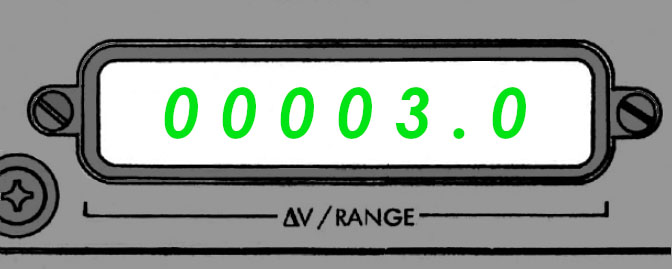
Their Delta-VC displayed on the EMS' digital counter.
002:46:37 Kerwin: Roger. You can't ask for much better than that. How about the burn time? Did you notice?
002:46:42 Haise: Okay. On my trusty watch, I had about 3¾ seconds long.
002:46:49 Kerwin: Okay. Copy that.


